Report
Overview of current conditions
Global private equity investment showed no significant increase in 2012, continuing 2011's trend towards flat growth. North America was the strongest-performing market, while activity in Asia fell around 20% over 2011. India saw deal activity fall from $14.8 billion in 2011 to $10.2 billion in 2012. The number of deals, however, increased from 531 to 551 over this period, highlighting a fall in average deal size.
Not surprising, limited partners (LPs) are showing increasing caution this year when allocating funds. In fact, 2012 saw 55 funds with a mandate to invest in India, but the total fund value allocated to India was only $3.5 billion, down from $6.8 billion in 2011. All this has been driven by the fact that 2012 was an uncertain year in India both politically and economically. Reported lapses in governance, coupled with a lack of clarity in regulation, raised considerable concerns about India's attractiveness as an investment destination. Despite these challenges, the market is showing signs of maturity with all key stakeholders becoming more comfortable with the idea of private equity (PE) funding. The latter half of 2012 also saw the government become more proactive and bring forward some key pieces of legislation to create greater transparency in the regulatory environment.
Fund-raising
India received only $3.5 billion of the $320 billion funding raised globally in 2012, according to UK research firm Preqin. General partners (GPs) also adopted a cautious approach, holding back to observe the performance of existing investments in a turbulent environment. In 2012, 80% of funding came from overseas investors, a theme that has been observed since the early days of private equity investment in India. There are no indicators that this trend will change soon, with traditional sources of PE capital in India, such as insurance companies and pension funds, inhibited by regulation from participating in this asset class.
Nonetheless, while 2013 undoubtedly holds several challenges for PE firms, raising capital is unlikely to be one of them. Our survey reveals that a majority of GPs rate "difficulty in raising capital" as seventh out of 11 challenges, far below concerns such as difficulty in exiting and mismatch in valuations. What is clear is that GPs will need to differentiate themselves to attract investors and prove they can deliver. They can do this by demonstrating a quality track record in investing and exiting.
Deal making
The volume of deals grew only slightly, from 531 in 2011 to 551 in 2012. At 4%, this increase is very low, in line with the overall mood of caution in the market last year. This restraint, coupled with a decline in the total funds invested, saw deal size significantly impacted, with average deal size falling from $28 million in 2011 to $18.4 million in 2012. Early-stage growth and venture capital (VC) have played a critical role in deal making in 2012, with the number of early-stage deals under $10 million almost doubling to 244. Also, the top 25 deals made up only $4.3 billion, as opposed to $5.9 billion in 2011, and the average deal size at the top 25 dropped by almost a quarter to $175 million per deal last year.
Sectors that attracted the most investment last year were healthcare and IT/ITES. The majority of deals under $10 million were made in the e-commerce space, which was a sector highlighted in Bain's India Private Equity Report 2012. The subsector continues to grow in 2013, following on the nearly doubling of deals valued at less than $10 million in the e-commerce space, from 12% in 2011 to 23% in 2012 of the total deals.
Expectations about deal activity in 2013 remain cautious but still positive on the whole. Our interviews suggest that deal activity will see moderate growth in 2013 throughout the industry. The steps taken towards improving India's legislative framework have made investors a bit more upbeat, and GPs suggest that more deals will close in 2013.
Portfolio management
PE investors we spoke to believe they add value to their portfolio companies in the form of vision and strategy, improving corporate governance and financial decision making. This marks a distinct change in their level of participation. Until recently, the support entrepreneurs sought was restricted primarily to customer access as well as domestic and international expansion plans. On the other hand, with growth and profit expansion hard to come by, PE investors are recognising the value of operating teams. Factor in the lack of exits and these teams become extremely critical to overall portfolio management.
Exits
There was a significant increase in the number of exits in 2012 compared with 2011―115 exits last year versus 88 the preceding year. This accounted for a total value of $6.8 billion, up from $4.1 billion in 2011. The most popular exit route for both VC and PE investments in India continues to be through public market sales, including IPOs.
The financial services sector accounted for around 35% of all exits. High-profile exits occurred from ICICI, HDFC and Kotak through a partial off-loading of stakes acquired from 2003-2007, as these companies moved to cash in on the resurgent Indian stock market.
A vast majority of firms we spoke to believe that exits will increase in 2013 based on the expectations that capital markets will bounce back, which will increase investor appetite for private-equity-backed IPOs.
In focus: The healthcare opportunity
The healthcare sector emerged as a sector of growth in a contracting PE industry in 2012, and this is expected to continue to grow this year. Investments in healthcare almost tripled over the past year, rising from $0.46 billion in 2011 to around $1.3 billion in 2012. Deal volume also rose 50%, with 44 deals done in the sector in 2012.
The overall Indian healthcare market is around $65 billion and has grown 11% in the past five years. However, India remains a highly underpenetrated market in terms of healthcare spending per capita and offers huge growth potential. India's growing population, increased incidence of diseases, greater affordability, expanding insurance coverage and supportive government schemes are the key drivers of high double-digit growth expectations of the PE industry.
About 140 healthcare companies have received investment over the past five years, with 15% to 20% raising more than one round of capital. What this points to is the increasing confidence in the value creation potential of the sector. Even in terms of exits, the picture is promising. Of the $5 billion invested in healthcare, $2.8 billion has been returned, with an average holding period of five years for the top 25 deals.
About this report
Bain & Company provides strategic guidance and advice to stakeholders across India's private equity (PE) landscape, including general partners (GPs) at PE funds, limited partners (LPs), entrepreneurs and regulators. Bain has played a key role in developing India's PE industry over the past decade, and we have drawn upon this experience for our private equity reports, which outline developments and trends in the industry, over the past four years. We are pleased to collaborate with the Indian Private Equity and Venture Capital Association (IVCA) in bringing you our latest edition.
Our India Private Equity Report 2013 contains in-depth analysis of India's PE landscape, including a close look at the growing healthcare sector, as well as our perspective on the future. Our conclusions were informed by interviews with stakeholders, including GPs at PE funds, LPs, entrepreneurs and regulators. We also drew from Bain's proprietary deal and exit databases, and an extensive survey of GPs at various PE funds.
In section 2, we examine the Indian private equity industry and identify the key trends that have shaped the past year. We identify the challenges still facing the sector and the changing attitudes of industry players, examining both through the lens of their wider political and economic context.
Section 3 gives an overview of each aspect of private equity investing: fund-raising, deal making, portfolio management and exits. We look at how the different elements of the investment process have evolved over the past year and outline perspectives from industry professionals for the year to come.
In section 4, we take a comprehensive look at the healthcare sector, which is attracting increasing investment, and examine the role that private equity plays.
Finally, in section 5, we step back and assess what these multiple factors mean for the future of PE investment in India. We analyse the current roles played by various stakeholders and make recommendations for how LPs, GPs, entrepreneurs and promoters can work to create a thriving investment climate.
1. Introduction: Slow growth for Indian PE amid political and economic uncertainty
Across the globe, 2012 was another volatile year. Europe struggled to maintain a coherent fiscal policy in the face of internal schisms and debates about the future of the euro. Spain's request for a $125 billion rescue for its financial sector was seen by many as a preliminary step towards a full bailout. Greek elections caused internal political unrest and economic ripples throughout the euro zone, triggering debate over whether Greece might leave the euro. On the other side of the Atlantic, politicians continued their game of brinkmanship over economic policy and brought the US to the edge of the so-called “fiscal cliff”.
However, the close of the year saw anxieties easing. President Obama's reelection guaranteed a certain level of continuity in US economic policy, and a deal struck in late December averted the fiscal cliff—for now. Even Europe began to show some signs of cheer, with Ireland on its way to participating in the bond markets towards the end of 2013.
In Asia, the story is still one of growth, albeit the high growth rates of previous years are gone: China reported only a 7% increase in GDP and India saw a drop to approximately 5% GDP growth in the third quarter of this financial year. Asia's stock markets also remained fairly positive—while the Shanghai Index grew by 5% between January and December, India's NIFTY saw strong growth of around 24%. This growth was mirrored in Western stock markets, with the S&P growing by 10%, NASDAQ by 11% and the German DAX by 31% (see Figure 1.1).
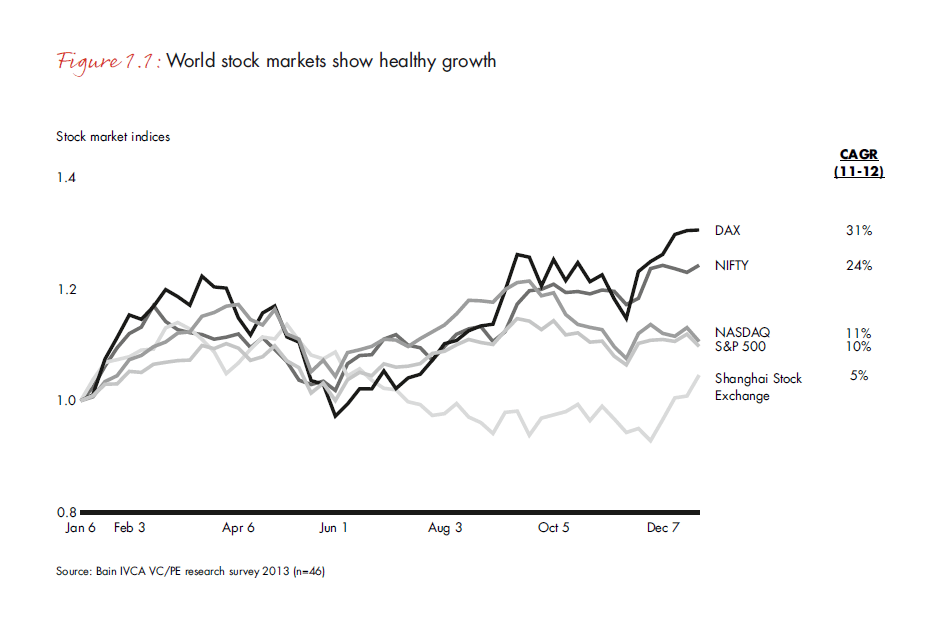
Despite the positive signs of growth, global private equity investment showed no significant increase, continuing 2011's trend of a flat growth rate. The only region to show an increase was North America (see Figure 1.2). The Asia-Pacific market declined by approximately 20%, and South Korea was the only nation to see an increase in PE activity (see Figure 1.3). Decreasing deal values in both India and China played a large part in causing that decline. In this report, we'll explore India's role in that trend and take an in-depth look at the country's changing private equity scene.
One of the main reasons for the declining investment in the Indian private equity industry is that LPs are showing more caution when allocating funds. In 2012, there were 55 funds with a mandate to invest in India, but the total fund value allocated was only around $3 billion, down from $7 billion in 2011 (see section 3 for details). What's more, LPs are becoming increasingly picky about the fund managers they work with.
Looking closely at the Indian PE scene, 2012 has been an uncertain year, both politically and economically. The year began with widespread protests against corruption and saw continuing controversy over issues ranging from the Maharashtra irrigation scandal to the debate over foreign direct investment (FDI) in the retail and aviation industries. Further hurdles were introduced, such as the retrospective tax amendments on the controversial Vodafone case, which raised concerns among investors. Also, discontent over the perception that the government lacks a clear policy road map has inevitably led to concerns about India's attractiveness as an investment destination.
Throughout the year, the value of funds invested in India through private equity declined by some 30%. Although the number of deals actually rose from 531 deals in 2011 to 551 deals in 2012, the trend towards an ever-smaller deal size meant that the value of funds put to work over the year dropped.
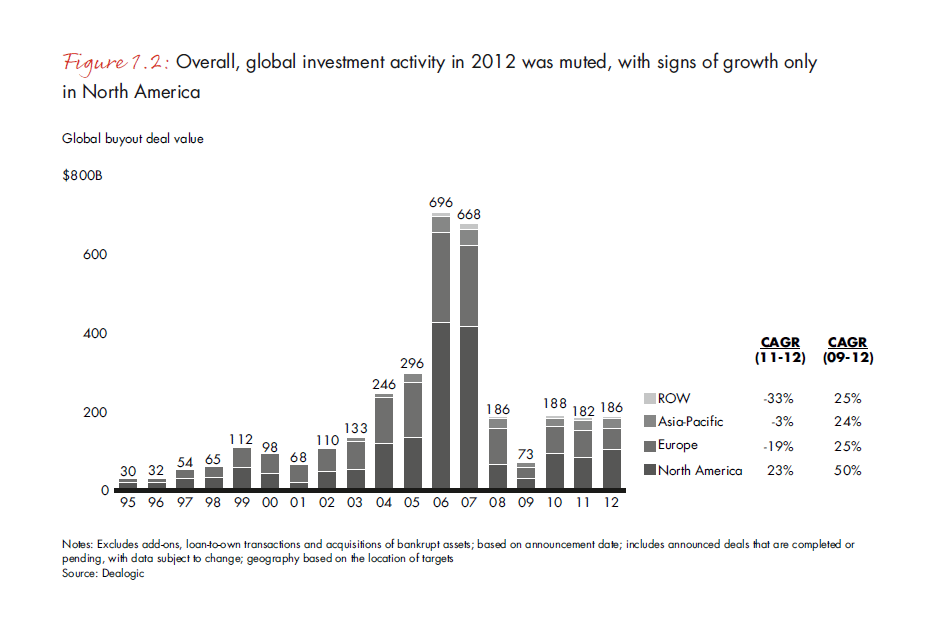
In terms of exits, 2012 was a good year. The number of exits increased significantly—115 exits (valued at approximately $7 billion) up from 88 exits in 2011 (valued at $4.1 billion). Financial services saw the biggest change, with a fivefold growth in exit value, from $390 million in 2011 to some $2 billion in 2012. A number of high-profile exits drove this change: Carlyle's $1.1 billion exit (in two phases) from HDFC, Temasek's $299 million exit from ICICI and Warburg's $460 million exit from Kotak.
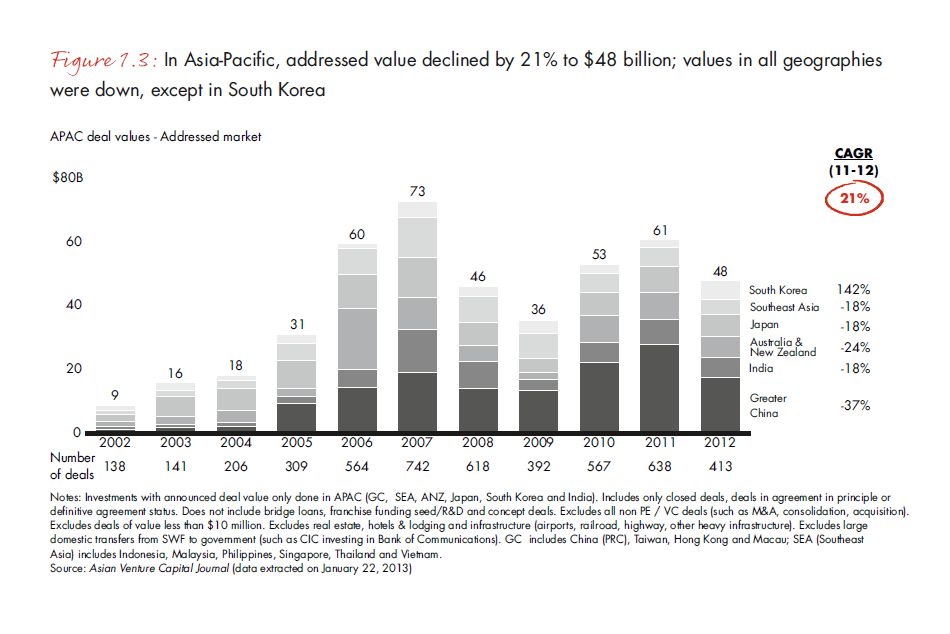
Overall, 2012 may be described as a year of caution for India's PE industry. In 2011, we saw an increase in activity with pent-up demand for capital after a long hiatus in investments. Our research points to a maturing market, with promoters gradually changing their attitudes towards private equity as a source of capital and PE firms growing increasingly careful about the deals they make. Moreover, the regulatory framework is improving, as we will discuss later on.
We believe that signs point to a positive future for India's private equity industry in the medium term. PE is increasingly seen as a credible source of patient capital, and the dynamic between investors and entrepreneurs is maturing and becoming one of trust. Despite some remaining issues, we see cause for optimism in the year to come.
2. Overview of the Indian PE landscape
In 2012, venture capital (VC) and private equity funds were more cautious about the selection of their investments and less willing to pay outsized valuations. Investors also began to demand a clear exit road map from the start, which resulted in more money committed through early-stage investments.
The year began on a high note, with optimism about the increased deal flow and the general future of the PE market. More than half of those surveyed for last year's report believed that deal activity would increase; indeed, 10% of respondents placed growth at 25% or more. However, that optimism was misplaced. Throughout 2012, the slowdown in the Indian economy caused increasing concern for GPs. Five issues staunched deal flow.
First, the logjam in India's political landscape, with fitful attempts at reform, worried investors. Second, the high inflation that began in 2011 continued for most of 2012. While it appeared to be stabilising by late 2012, average inflation was 7.5% during the year. Third, low Index of Industrial Production growth, which was negative in some months (0.1% in April, negative 1.8% in June, negative 0.2% in July), caused concern. Fourth, the weakness of the rupee, which hit a historic low of INR 57 to the US dollar, affected investors' willingness to commit.
Finally, regulatory uncertainty was an issue throughout the year and played a large part in scaring investors away from India. The threat of retrospective tax on foreign investors that had taken controlling stakes in Indian companies provoked widespread debate. This was compounded by the prospect of the government imposing a capital gains tax on PE investment returns. In an environment characterised by mounting pressure to exit (with target IRRs in the high teens), the possibility of a capital gains tax was a cause of negative sentiment among investors. At the beginning of 2012, the Indian private equity market had seemed to be on an upward trajectory, but by mid-year, the road ahead seemed increasingly bumpy.
Despite these setbacks, there is no doubt that private equity has become a viable source of patient capital in India. The number of deals in 2012 grew by some 4% from 2011, indicating that more and more promoters and entrepreneurs are comfortable with the idea of PE investment.
That said, India lost its standing as the fastest-growing private equity market in Asia, declining at a rate of 30% (see Figure 2.1). In 2011, PE investments reached the equivalent of 0.8% of GDP, according to Euromonitor. In 2012, this figure dropped to 0.5%. This percentage is higher than those of China (0.26%) and Brazil (0.26%), though lower than those of more developed markets.
Key trends for PE
There are a few key reasons for the drop in investments, mostly linked to India's wider financial and political landscape. The decline of capital expansion plans across industries brought about a decrease in the demand for growth capital. Additionally, many large sectors—like infrastructure, energy and telecom—suffered due to inadequate political momentum and saw investments almost completely dry up. Ongoing regulatory uncertainty compounded this problem.
An overview of 2012 indicates the emergence of four important trends, which will shape the future development of the private equity space:
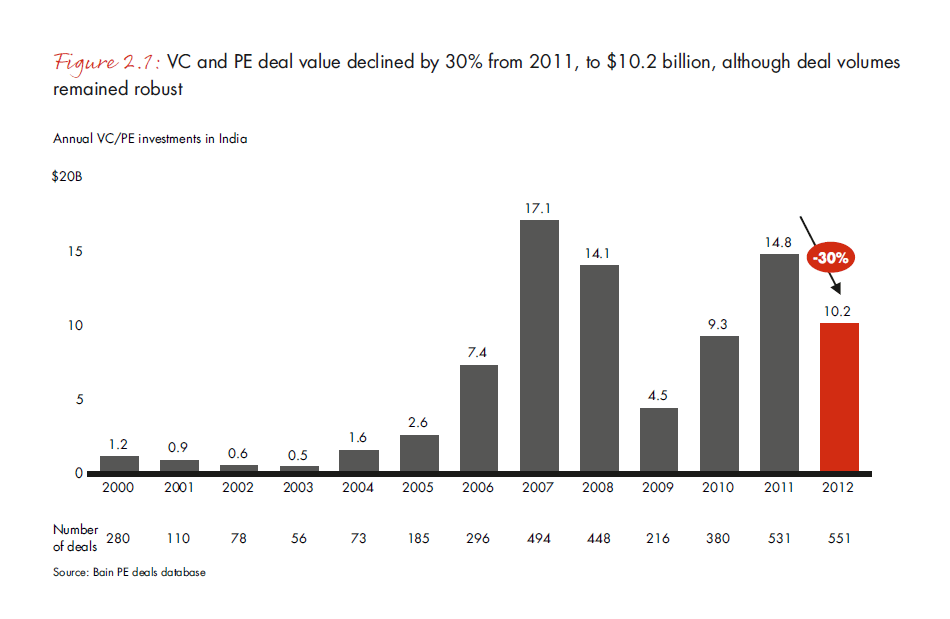
- Fund-raising activity has slowed, and LPs are doing their diligence with great care before committing funds to India. The total funds mandated for investments in India were $3.5 billion in 2012, which is less than half of the roughly $6.9 billion committed in 2011.
- Early-stage growth and venture capital are playing a critical role in deal making. The number of early-stage deals that were less than $10 million nearly doubled from 125 deals in 2011 to 244 deals in 2012. This subset now accounts for almost half of total deal volume (44%), up from 24% in 2011 and 16% in 2010.
- Investment is rising in consumer sectors, particularly in healthcare. Investments in healthcare nearly tripled over the past year, rising from $0.46 billion to nearly $1.3 billion in 2012. The number of deals also rose by 50%, with 44 deals made in the sector in 2012.
- The pressure to exit continues to build. Though exits grew slightly in 2012, there is a growing backlog of investments looking to exit, mainly five-year vintage or older funds. As long as capital markets remain unattractive and investors continue to prefer IPOs as a way to exit, this backlog will continue to grow.
Issues to watch in 2013
Although these issues create some cause for concern, we have reason to believe that the fundamentals of the Indian PE market are sound. The LPs and GPs we have interviewed unanimously believe in the long-term potential of private equity in India and in India's growth story. While the economy may have slowed down, GDP continues on its upward trajectory, bringing continual increases in trade flows, industrial production and consumer spending. India's middle class grows by the day, pushing more and more households above the baseline for additional spending and creating a thriving upper middle class, with large disposable incomes.
To gain a better perspective on what they perceive to be the main impediments to growth, we surveyed key industry stakeholders and asked them to identify the challenges for private equity in 2013. The results are similar to last year's findings (see Figure 2.2).
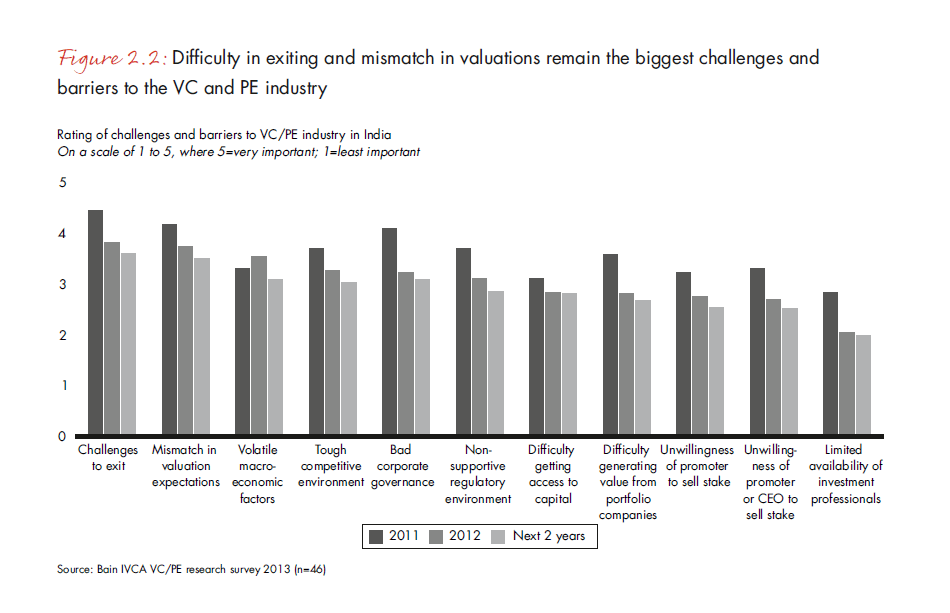
- Concern about returns. Not all investments have generated the returns expected of them. This is particularly true of investments made during the boom years of 2004 through 2007, which are now reaching maturity. Their performance is causing concern among LPs.
- Expectations mismatch over asset valuations. Despite the trend towards more realistic valuations, GPs believe that high-quality deals are still pricey and will remain so.
- Sustained pressure on exits. This year, pressure to exit was ranked by GPs as the biggest challenge they face. The number of exits may have increased in 2012, but there is still some distance to go; many investments from 2006 and 2007 have exceeded their five-year holding period. Although the wider economic context no doubt played a role in impeding exits, the GPs we spoke to agree that some investments made during that time were not based on sound fundamentals.
- Value creation. Indian entrepreneurs are not fully open to having PE funds actively participate in their company's strategy and operations, and PE funds continue to get opportunities to acquire only minority stakes.
- Macroeconomic environment. India's performance in GDP growth, inflation and other economic factors was disappointing throughout 2012. As a result, “macroeconomic factors” replaced “non-supportive regulatory environment” on investors' list of top five concerns—a change from the prior year. While the policy framework remains uncertain and continues to deter investment, government reforms embarked on towards the end of 2012 have done a lot to dispel fears.
3. An in-depth perspective on Indian PE, now and over the intermediate term
Fund-raising
Today's baseline: Stable but slowing
Last year may have seen considerable activity in the flow of investments, but the decrease in the number of exits (which we explore in more detail later on) has had an undeniable impact on fund-raising. LPs are growing impatient, the pressure is mounting on PE funds to make profitable exits and the net effect is that general enthusiasm towards India as an investment destination has waned.
Globally, around 675 funds raised approximately $320 billion in 2012, according to UK research firm Preqin. But a close examination of the research reveals that of that total, only around $3 billion was mandated for investment in India, whereas the sum mandated for India in 2011 was $7 billion1—a substantial drop and an indicator of the change in global attitudes towards India (see Figure 3.1). It's fair to assume that GPs that have money are holding back to see how the current crop of investments fares in the coming year. As India's PE sector matures, there is no doubt that LPs are becoming more selective with their investments.
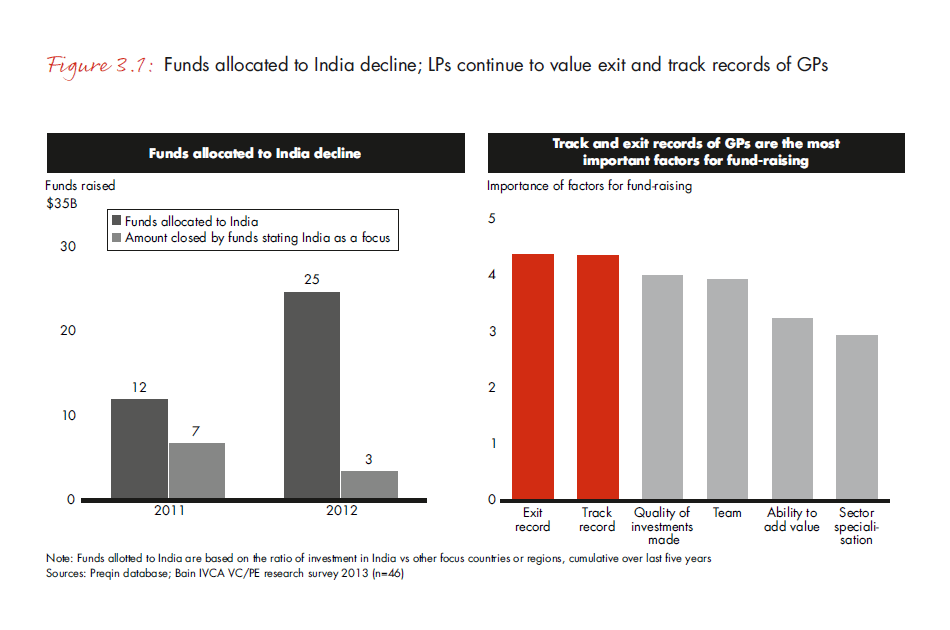
One aspect of fund-raising that stayed constant over the last two years is the proportion of funds raised overseas, which remains at about 80%. This figure has not changed significantly since the early days of private equity investment in India, and there are no indicators that it will improve soon. India's complex regulatory framework and legal system mean that domestic funding comes only through high-net-worth individuals or institutions. Conventional sources of PE capital, such as insurance companies and pension funds, are still not allowed under Indian regulations to provide capital to PE, VC or other alternative asset classes. As a result, funds that invest in India prefer to raise money overseas to avoid complications with Indian law over dispute arbitration, taxation and redemption.
Finally, it's noticeable that LPs are increasing their scrutiny of GPs' track records before deciding to commit funds. The majority of our survey respondents highlighted the challenges they face in finding GPs with a track record of success. When LPs were asked to rank the factors that influence their decision making when committing funds to a GP, track and exit records were on top, followed by the quality of investments and the GP team.
2013 and beyond
Overall, the prospects for fund-raising in 2013 look positive. When it comes to dry powder, there has been a distinct year-over-year improvement. PE funds entered 2013 with $11 billion for investment—nearly one-third less than the $17 billion that remained in January 2012—according to Preqin. This decline in capital overhang is undoubtedly good news, but it's worth noting that the underlying reason for this decline is not, as one might hope, the result of increased investments, but rather a reduction in the value of incoming funds.
While 2013 undoubtedly poses challenges for PE firms, raising capital is not likely to be one of them. The majority of GPs we surveyed ranked “difficulty in raising capital” seventh among 11 challenges, far below concerns such as “difficulty in exiting” and “mismatch in valuations” (as discussed in section 2). What players looking to raise funds need to acknowledge, however, is that LPs are becoming more selective and competition is growing more intense. GPs will need to differentiate themselves on returns in order to attract investment. They will also need to prove they can deliver by demonstrating a quality track record in investing and exiting.
That means newcomers are likely to face challenges. First-time fund-raisers are entering a world in which other GPs have a head start; some GPs may already be on their third round of fund-raising. In 2013, a lack of a proven track record will matter more than it did in previous years.
More established players face challenges too. Even if their first and second funds have seen reasonable success in deployment, that will not be enough to convince investors. It's the all-important track record on exits that will be critical and, as this report explores in more depth later, exiting will continue to pose challenges in 2013. The pressure to perform is only going to increase.
When it comes to the balance between domestic and foreign investment, there are few signs of change in the status quo. The economic reforms of 2012 did not reduce the stringent regulations on PE investments, and waiting for affluent individuals in India to take action is unlikely to push domestic investment higher. Our interview respondents confirmed that 2013 will continue to see the majority of investments coming from outside India, with two-thirds coming from foreign direct investment (FDI) and foreign venture capital investment (FVCI). Within the 15% to 20% of funds originating in India, institutional investors are expected to contribute to a higher share of fund-raising as noninstitutional investors, such as high-net-worth individuals, reduce their investment in India (see Figure 3.2).
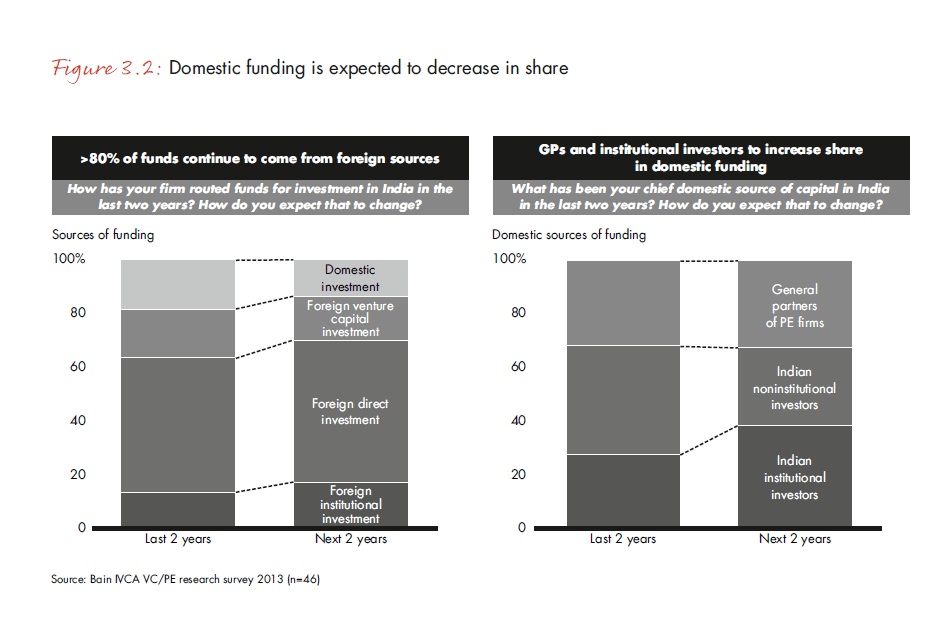
Deal making
Today's baseline: Conservative and uneven signs of growth
Turning to deals, some interesting trends appeared in 2012. While the GPs we surveyed reported receiving an average of 180 investment memorandums from potential investees—a big increase from the average of 100 reported in 2011—the volume of deals grew only slightly, from 531 deals in 2011 to 551 deals in 2012. At 4%, this increase is very low and in line with the overall caution the market has seen throughout the year. What's more, this slight increase in deal volume did not stop the value of invested funds from decreasing 30%, from $14.8 billion in 2011 to just $10.2 billion in 2012. Promoters were unwilling to divest, faced with what they considered to be low valuations, and struggled to find common ground with funds, whose concerns over regulation fuelled their reluctance to invest in elevated valuations.
The drop in total funds invested had a significant impact on average deal size, which decreased from $28 million in 2011 to $18 million in 2012 (see Figure 3.3). However, a closer look shows a more complex picture and reveals the role that early-stage growth and venture capital have played in deal making in 2012. Between 2011 and 2013, the number of early-stage deals that were less than $10 million nearly doubled, from 125 deals in 2011 to 244 deals in 2012—a clear sign of the increasing role that such deals are playing in the private equity scene. Once these early-stage deals valued at less than $10 million are taken out of the picture, average deal size remains remarkably consistent from 2011 onward.
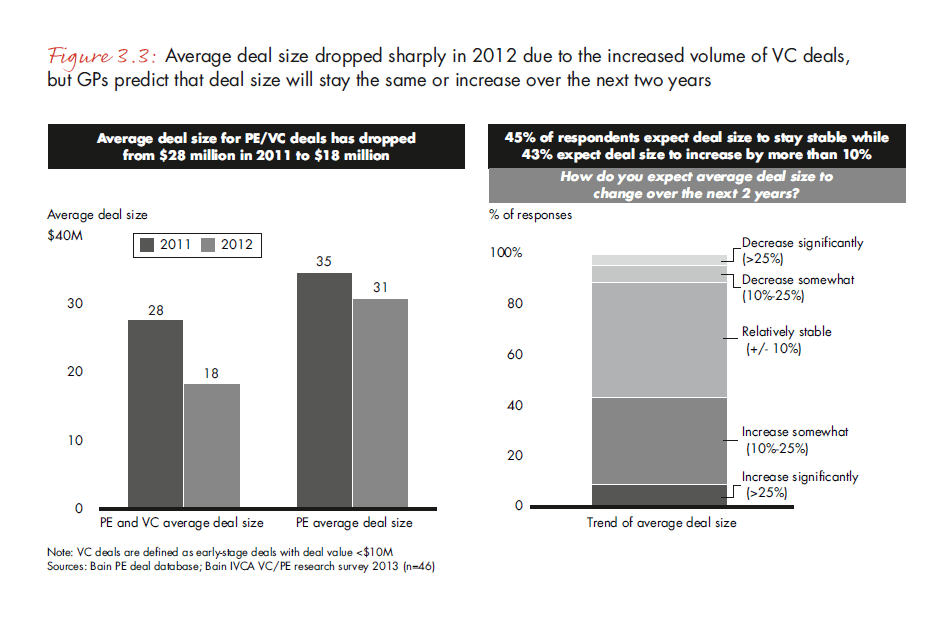
Our interviews suggest that the average PE deal size is likely to increase rather than decrease in 2013 for multiple reasons. Economic growth continues at a significant rate, despite unease over the 2012 slowdown, and will inevitably power growth in investments. As the PE scene matures, follow-on investments will grow, pushing up average deal size. And in an increasingly unpredictable environment, investors are likely to stick to bigger firms that offer less risk.
The $10 million decline in average deal size was accompanied by a drop in megadeals in 2012. The top 25 deals made up only $4.3 billion, as opposed to $5.9 billion in 2011, and the average deal size at the top dropped by nearly a quarter, to $175 million (see Figure 3.4). The vast majority of these megadeals were less than $200 million. Indeed, only two deals were of significant size—Bain Capital's $1 billion investment in Genpact and Lodha Developer/Vornado Trust's $500 million investment in Jawala Real Estate. In parallel, the number of smaller deals (less than $10 million) rose by 40% in 2012, from 260 deals to 357 deals.
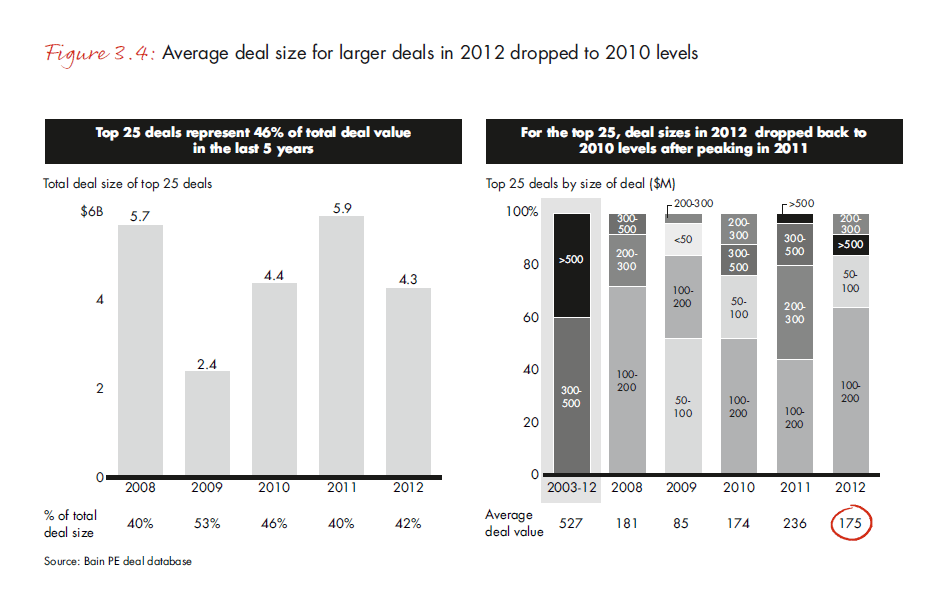
A closer look at investments of less than $10 million shows significant growth in the healthcare, IT and IT-enabled services (ITES) sectors (see Figure 3.5). Of the 360 deals valued at less than $10 million, over half were in IT and ITES. Education is also a growing space in this deal-size bracket, with 14 smaller investments over the course of the year. More than 40% of healthcare deals (20 deals out of 44) were valued at less than $10 million as well.
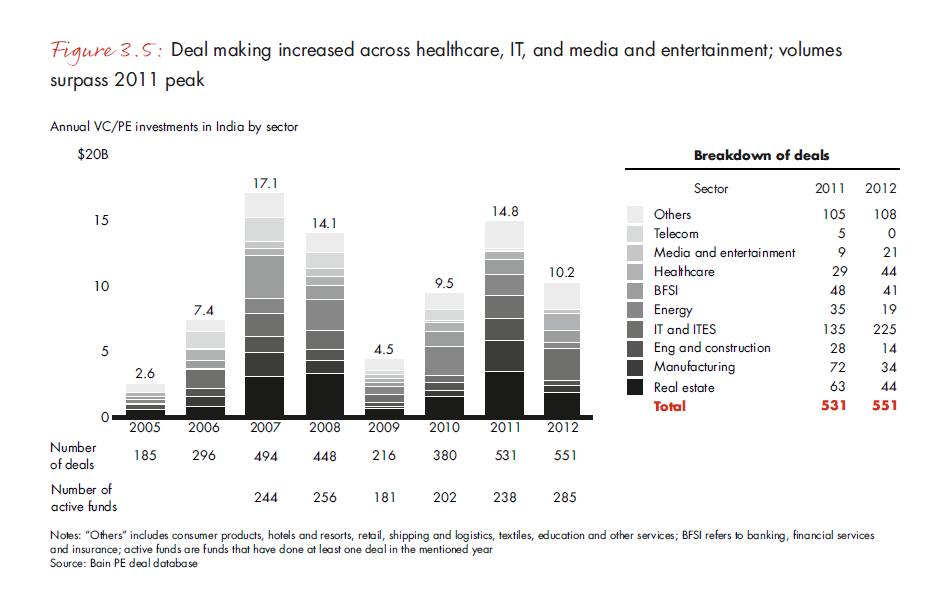
Within the IT and ITES sector, the $1 billion deal struck by Bain Capital and GIC over Genpact significantly increased the total sum invested. But the sector has also seen a number of deals with small firms operating in niche segments, such as e-commerce and online search engine services.
The majority of deals valued at less than $10 million were made in the e-commerce space and venture capital firms, in particular, played a role here, investing in start-ups in new areas such as mobile value-added services. The percentage of these deals in the e-commerce space has nearly doubled, from 12% in 2011 to 23% in 2012.
Last year's report identified e-commerce as a crucial trend in India's private equity scene, and this subsector continues to grow. About 98 of the 225 IT and ITES deals were made in the e-commerce subsector—a volume growth of 44% from 2011. The largest deal in 2011 was SoftBank's $200 million investment in InMobi, a mobile advertising network. In 2012, the largest single e-commerce deal was Tiger Global and Accel India's joint investment in Flipkart, the five-year-old online retail venture. Another notable investment was the $60 million that Sequoia Capital and SAP Ventures put into JustDial, a local helpline and search engine.
Deal size in e-commerce remains small and, in fact, has grown slightly smaller since last year. In 2012, 85% of e-commerce deals were less than $10 million, up from 75% in 2011. The stage of investment has also changed slightly: In 2012, around 80% of e-commerce deals were early-stage, up from 70% in 2011.
Some 40 deals were made in the healthcare sector, a dynamic space that has evolved rapidly over the past year due to its recession-proof nature and frequent need for business guidance from investors. Whereas investments in healthcare historically focused on pharmaceuticals and diagnostics, PE funds more recently have focused their attention on frontline providers and delivery services. Section 4 of this report looks in detail at the healthcare sector and examines this trend in depth.
Financial services has seen little change in investment levels; they were down slightly to $0.9 billion from $1.1 billion in 2011. But real estate, manufacturing and infrastructure have all declined significantly from the high levels reached in 2011. Real estate investments have halved, from $3.4 billion in 2011 to $1.8 billion in 2012. Manufacturing and infrastructure investments have collapsed, from $2.4 billion and $3.3 billion, respectively, in 2011 to $0.6 billion and $0.8 billion in 2012. These reflect problems in India's infrastructure space in general, with fewer contracts awarded and the threat of governance issues making investors wary of committing. The GPs we spoke to attribute this slowdown in India's infrastructure space to poor valuations and a “wishy-washy” government that is unwilling to take the necessary steps to improve matters.
Increasingly, India is seeing new investors. The number of active funds increased for the second year in a row, rising from 202 funds in 2010 to 285 funds in 2012. In 2012, this was driven by a sharp increase in the number of new funds (see Figure 3.6).
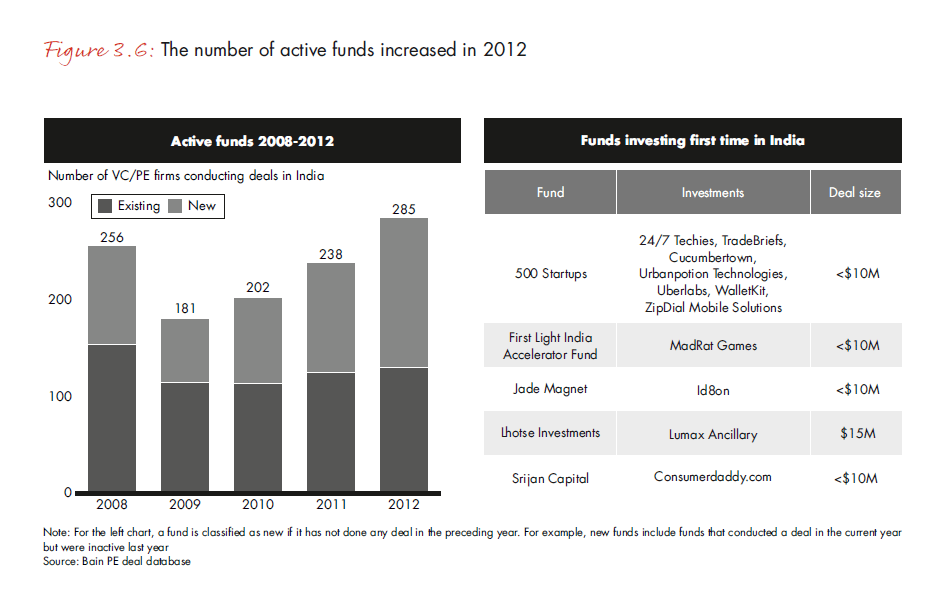
The increasing overlap between venture capital and private equity investors that we saw in 2011 continued to grow. Deal size alone is no longer the predictor it once was. Small deals that would previously have been within VC parameters now see competition from both VC and PE players. Established PE player Accel India has invested about $20 million each in online ventures BookMyShow and Myntra. On the flip side, Sequoia Capital, a venture capital fund, has participated in multiple consortiums, investing more than $10 million, with investments including Manappuram Finance & Leasing and July Systems.
When it comes to valuations, funds have become more conservative about the entry multiples of their investments. Average EBITDA multiples on merger and acquisition transactions in India were already dropping last year, from a high of 20 times EBITDA in the period from 2006 to 2008 to 15 times EBITDA in years 2010 and 2011. The 2012 multiple was even lower, eight times EBITDA, driven by a decline in multiples for consumer staples and the financial services sector (see Figure 3.7).
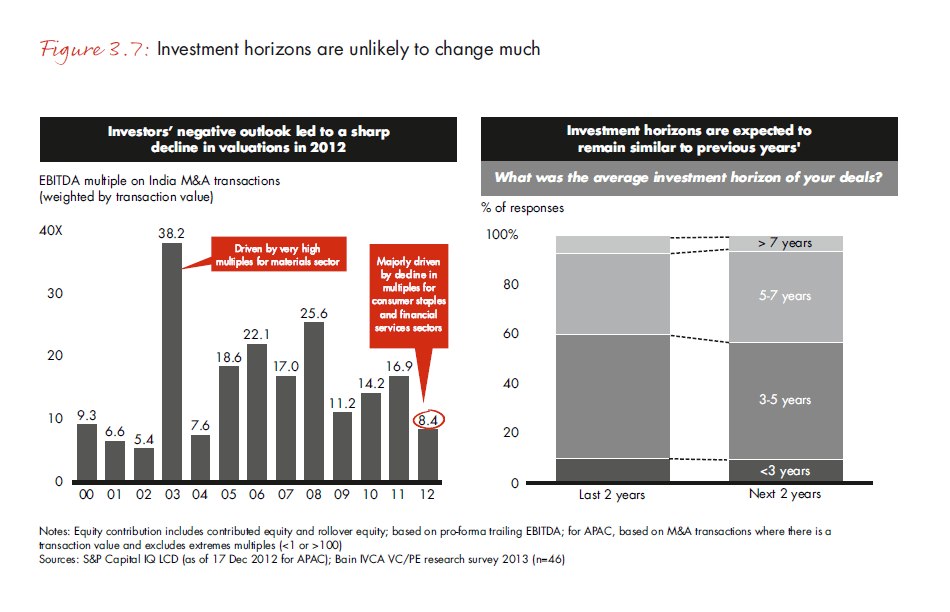
Although valuations have dropped significantly from 2007 levels, there are reasons to believe this drop will not continue. As capital markets show signs of improvement, promoters are likely to expect higher multiples.
Our survey shows that about 50% of GPs expect valuations to stay steady, despite the fact that 75% feel that current valuations are inflated (see Figure 3.8). The lack of quality assets shows no signs of changing and will continue to keep valuations at their current levels. One consequence worth noting, however, is that the paucity of deals involving quality assets has continued to make those assets pricey.
When it comes to holding time, about half of GPs expect the current holding periods of three to five years to continue, while around a third expect holding periods to rise slightly.
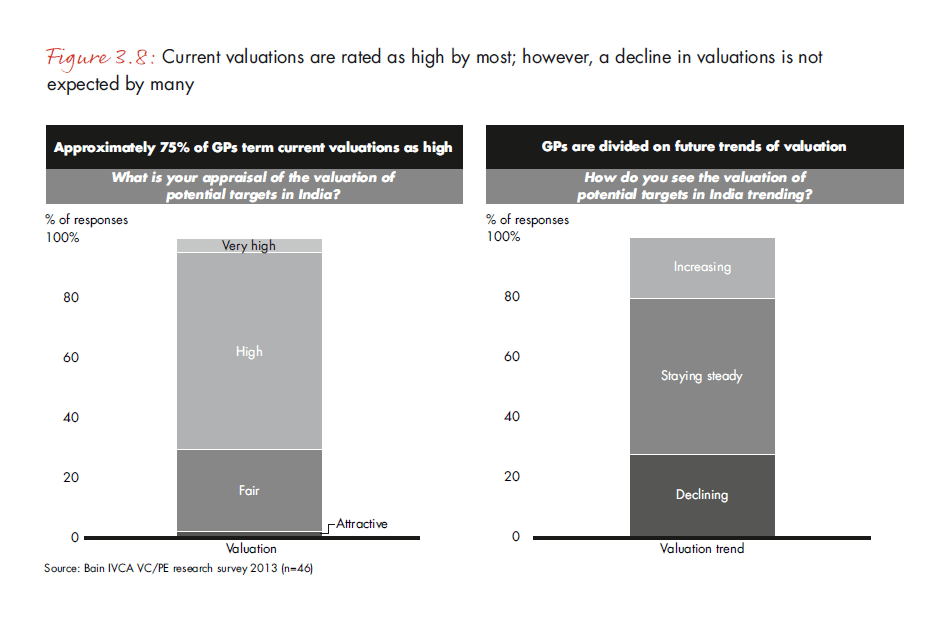
The majority of PE deals continues to involve minority stakes, reflecting the nascent stage of India's private equity market. However, our last report predicted that this would gradually change, and we are seeing this borne out. The percentage of deals acquiring minority stakes has dropped from 95% in 2011 to 86% in 2012 (see Figure 3.9). Our survey shows that PE practitioners are likely to increase the number of instances in which they acquire a controlling stake, indicating a change in the relationship between investors and entrepreneurs.
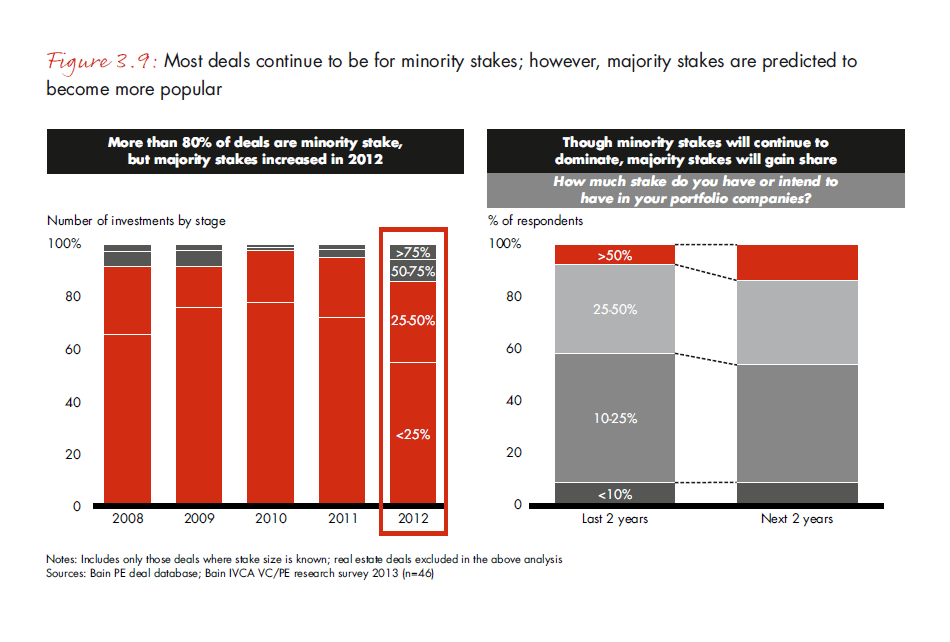
The proportion of late-stage deals also continued to decline, from around 30% in 2009 to 2010 to 15% in 2012, and the trend is expected to continue. The choppiness of the capital markets had a knock-on effect on private equity, causing a big drop in pre-IPO deals and making several entrepreneurs choose to defer their IPOs.
The number of buyouts decreased, from 25 transactions in 2011 to 15 transactions in 2012 (see Figure 3.10). However, more than 60% of survey respondents believe that buyouts will most likely see an increase in 2013, citing changing attitudes of promoters and the slower rate of growth in the economy as factors for this growth. Our interviews suggest that many stakeholders believe most Indian buyouts so far have not been genuine, as promoters have continued to run the businesses after handing over controlling stakes. However, this trend is beginning to change. Larger firms are leading the way, with families such as the Singhs of Ranbaxy agreeing to relinquish control and live off money in the bank, and GPs believe this trend will trickle down to smaller businesses, eventually.
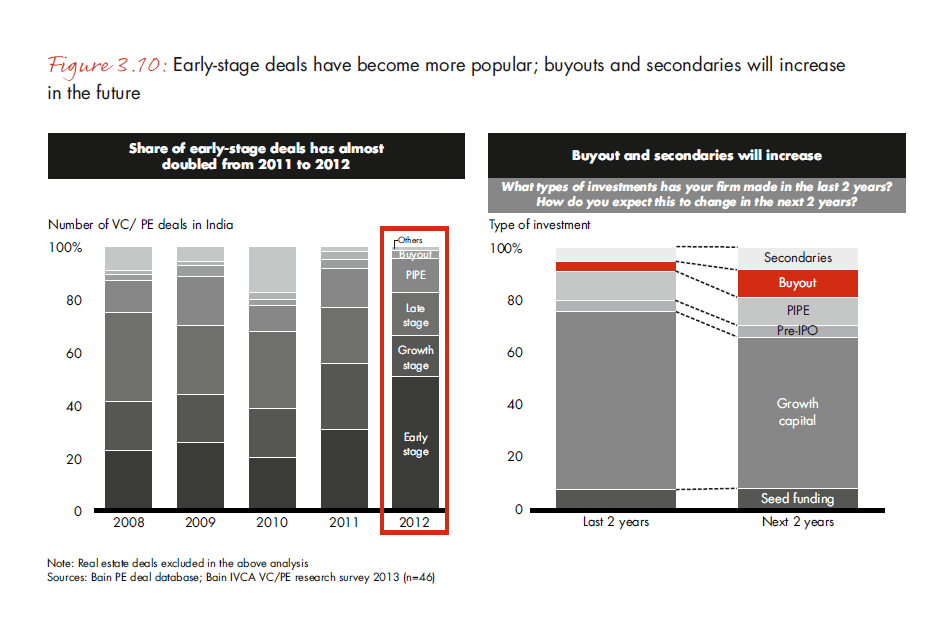
Secondaries are also slated to increase. In the early days of India's private equity scene, secondary buyouts occurred when funds were unable to meet the requisite deal size without buying out the older fund's stake.
This is no longer the case; instead, private equity players are taking the initiative. Indeed, Goldman Sachs has raised a $5 billion fund (Vintage Fund VI), focusing exclusively on the secondary market. In our survey, some GPs confirmed that they have been approached by other funds to buy out their portfolio firms, while others stated that they have looked at the portfolios of other funds and explored a secondary purchase. And in their opinion, secondary growth is likely to be boosted by the lack of IPOs and primary exits.
Finally, the number of deals channeling private investment in public equity (PIPE) fell, from 71 deals in 2011 to 67 deals in 2012. Nonetheless, some 23% of total funds invested were through PIPE deals, one of the highest percentages in the recent history of Indian PE. Our conversations with practitioners suggest that PIPEs in India are here to stay, as several attractive assets are unable to find the liquidity they need through public channels.
2013 and beyond
Expectations for deal activity in 2013 remain cautious but still positive. Of those we interviewed, 45% expect to see moderate growth throughout the industry in the next year (see Figure 3.11). The steps taken towards improving India's legislative framework have had a positive effect on predictions, and GPs believe more deals will be closed in 2013. Predictions for the medium term are similar to those made for 2012, according to our survey, with 60% of respondents believing the industry will witness moderate growth. However, fewer respondents expect high-growth figures (10% to 25%).
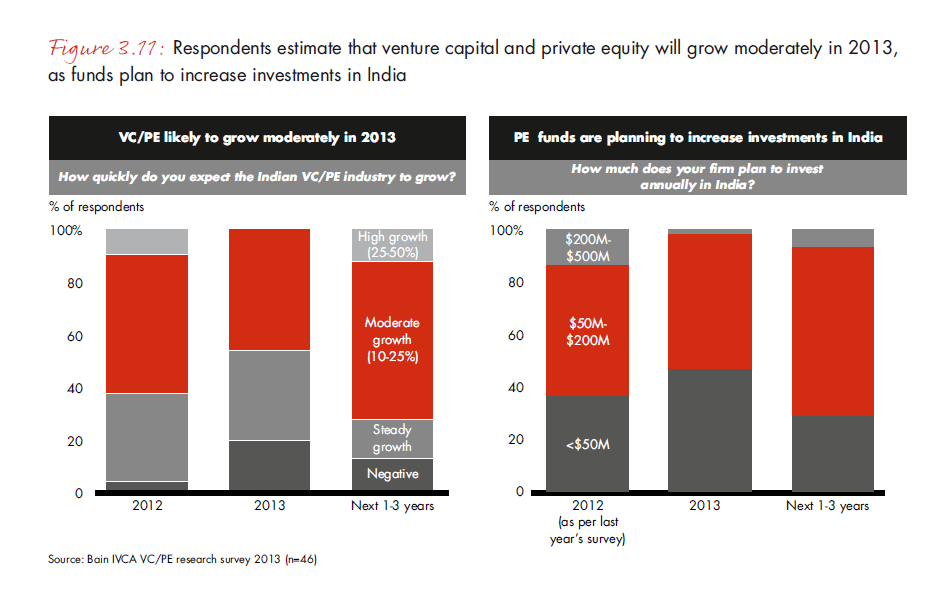
When asked about their own intentions for investing in 2013, only 51% of those we spoke to plan to invest between $50 million and $200 million, whereas for the medium term (three to five years), this percentage leaps to 95%. Nearly half of the respondents (45%) are looking to invest less than $50 million in 2013—up from 35% in 2012.
We predict that growth will continue in healthcare and consumer products. Healthcare, as we noted earlier, is a recession-proof field, with growth predicted at more than 15% as infrastructure and insurance penetration rates improve. Consumer products have shown some resilience in troubled economic times, and there's a distinct increase in investments in food and beverages over the last two to four years. We believe also that education will continue its upward trajectory and attract increasing levels of investment. However, telecom and real estate are likely to remain low on investors' list of priorities (see Figure 3.12).
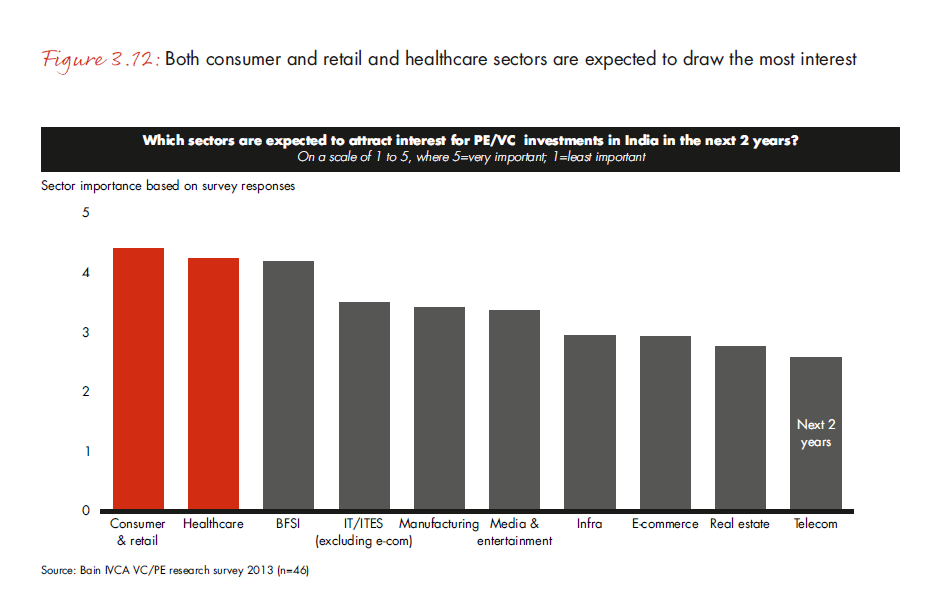
One certainty is that the Indian market will continue to be heavily intermediated, and fund networks and banks are likely to play a significant role in deal sourcing (see Figure 3.13). Having said this, most PE practitioners we spoke to agreed that they will work harder to source deals. This entails establishing a close and cordial relationship with entrepreneurs and engaging with them as early as possible—sometimes even before the promoter starts thinking about raising VC or PE capital.
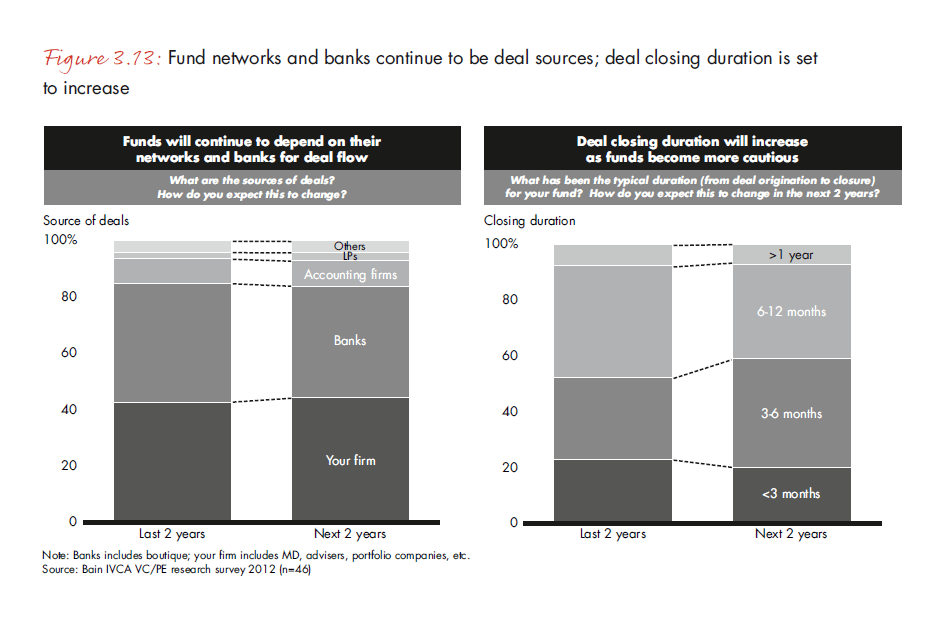
Our survey reveals that entrepreneurs are increasingly looking at valuation, followed by brand and sector experience, when choosing a partner for PE funding (see Figure 3.14). As Indian entrepreneurs grow savvier, there is increasing pressure on PE funds to develop sector expertise. Nonetheless, LPs recognise that the Indian market is still not deep enough for specialisation in all sectors.
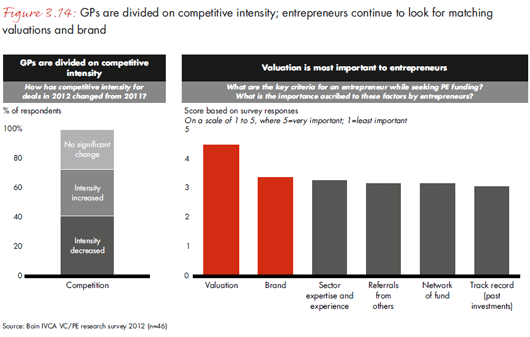
Those we interviewed were aware that a fund focusing on niche sectors would find it difficult to maintain a robust pipeline. The onus is therefore on PE practitioners to come up with innovative ways of differentiating themselves to entrepreneurs.
In the future, funds expect to spend an increasing amount of time on the deal closure process. Investors reported that around 30% of deals took between three and six months to close and another 50% took more than six months. This is evidence of an increasing focus on commercial diligence across multiple parameters.
However, market opinion is divided on the level of competition that is likely in the coming year. Around a third of survey respondents believe that the existing competitive intensity will continue, citing the current capital overhang and lack of compelling deals. About 40% suggested that 2013 will actually see a decrease in competition, stating that several GPs no longer have capital to invest and are unlikely to be able to raise more. As the deals from the 2007 to 2008 boom period come closer to exit points, the number of funds in the Indian market will almost certainly shrink. Competition from capital and debt markets is also likely to alter the scene, as current market conditions stabilise. The lack of quality and proprietary deals leads us to believe that competitive intensity will continue at its 2012 level throughout 2013.
Finally, our survey informs us that the financing options used by funds are unlikely to change by much, as straight equity and convertible instruments continue to account for over 90% of funding. Convertibles may increase their share slightly, and we also believe that mezzanine loans will appear more frequently as a financing option in the next two years.
Portfolio management
Today's baseline: An increasingly active role from investors
The role that investors play shows the difference between India's private equity scene and those of more developed markets. In India, PE investors can be seen playing an advisory role, monitoring their investments periodically through channels such as board participation, management information systems and regular updates from senior management. Beyond this, their participation is on a “needs” basis and is generally initiated by the promoter. The PE investors we spoke with believe they add value to their portfolio companies by making improvements in the company's corporate governance, vision and strategy, and financial decision making (see Figure 3.15). Until recently, this has been at odds with the support entrepreneurs have looked for from their PE investors, which was restricted primarily to gaining customer access and seeking guidance on domestic and international expansion plans. However this mismatch in expectations is starting to change, with both sides having a better understanding of the other's point of view.
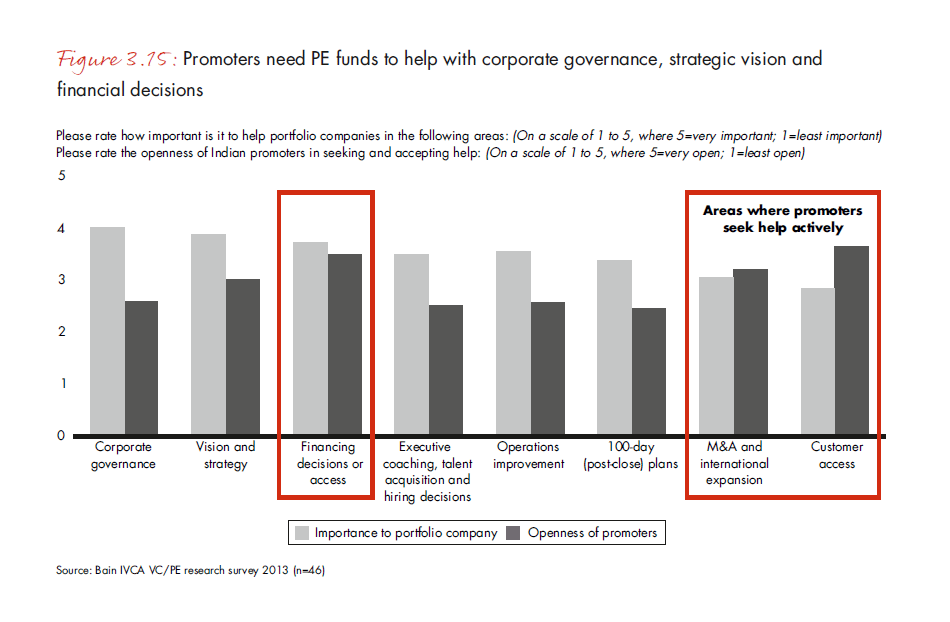
While investors believe that entrepreneurs are changing their attitudes towards private equity support, there is nonetheless a continued mismatch in the support offered by PE and the support that is accepted. The investors we spoke with believe there is a gap to bridge in such areas as executive coaching, operational improvements and 100- day blueprints.
There's no doubt that the role of the PE investor is evolving. Funds are coming to realise that they have insufficient bandwidth to manage their portfolio companies while continuing to source and conduct due diligence on new deals. Over the past year, we've seen more and more funds building operating teams as the realisation hits that achieving growth and profit in their portfolio companies is not easy. These operating teams are also needed to handle the rapidly growing unexited portfolio that most PE and VC firms are facing.
In addition, promoters are expecting investors to add value, rather than just inject cash, and are more open to investors taking an active role in the company. In our survey, among the funds that currently don't have an operating team, some 50% considered putting one together, and of this group, nearly half felt it was an immediate priority.
2013 and beyond
Promoters' understanding of private equity's value proposition is likely to improve in the next year, according to our survey respondents. An overwhelming 68% agreed that Indian entrepreneurs and promoters will become more conversant with PE's advantages over the next two years (see Figure 3.16).
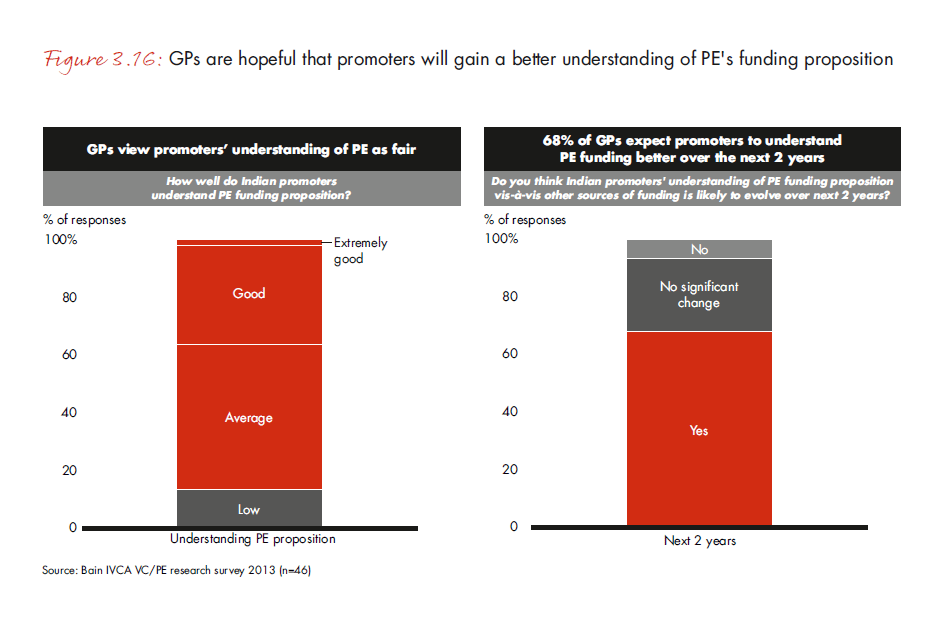
When speaking with entrepreneurs about portfolio management, we found that many would like to see more clarity on best practice for how funds engage with their investment companies. There are positive signs of a move towards this clarity:
- Private equity funds are increasingly using diligence findings and reports to share their value-creation blueprint with management. Indeed, diligence reports are increasingly used as strategic documents and at times even as the basis for a “100-day blueprint”.
- Funds are taking increasing care to align their expectations for value addition with those of management. The best examples of this are funds that are outlining the areas in which they expect to enhance value (corporate government or strategy, for example) and giving clear examples of how they have added value with past investments. In return, they are demanding that the managers of their investment companies be up front about their expectations from funders.
- Funds are increasingly seeing the need to demonstrate immediate impact, for example, by sharing customer contacts. In this way, they build trust from the start and confidence, on both sides, about the outcome of the funding relationship.
Exits
Today's baseline: An upward trend
The year 2012 has witnessed a significant increase in the number of exits. After many years of low exit rates compared with new deals, the number of exits rose—from 88 exits in 2011 to 115 exits in 2012—with a total value of $6.8 billion, up from $4.1 billion in 2011 (see Figure 3.17).
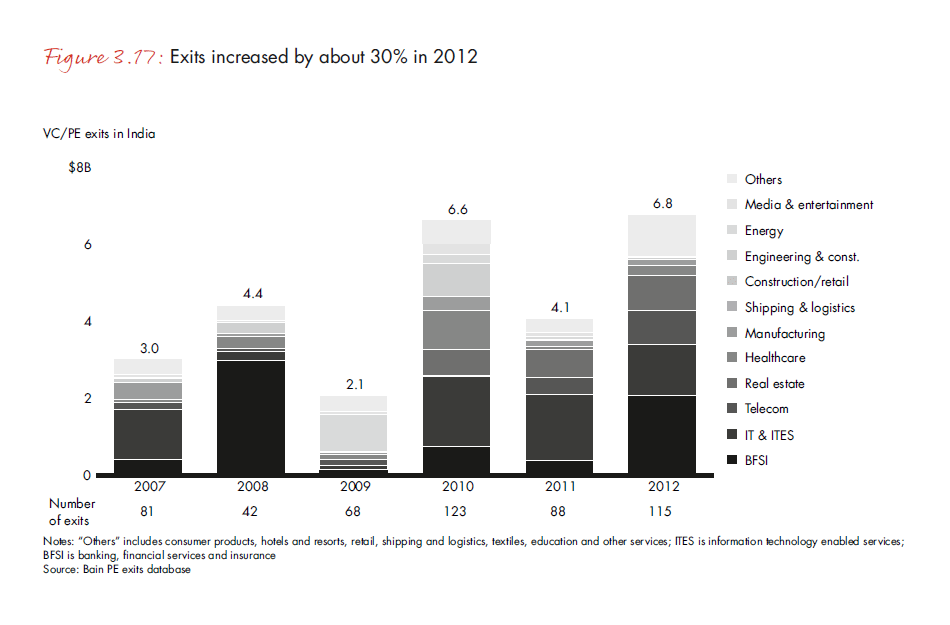
The most popular exit route for both venture capital and private equity investments in India continues to be through public market sales, including IPOs (see Figure 3.18). While the proportion of deals exiting through public markets remained the same at about 40%, the percentage of the total exit value almost doubled, from 25% in 2011 to 48% in 2012. A significant chunk of this IPO exit value was the $763 million exit from Bharti-Infratel by Goldman Sachs, Temasek and Macquarie.
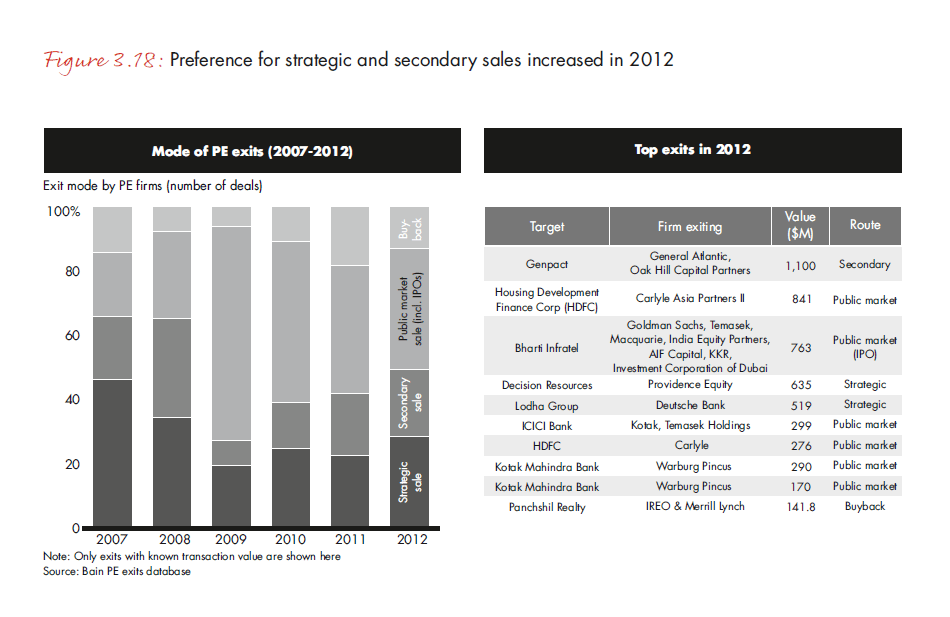
Part of this increase may be attributed to the fact that many IPOs of PE-backed companies due to occur in 2011 were deferred and showed up in 2012 figures. In addition to the public markets, promoter buybacks and secondary sales were also popular exit routes. Together, secondary and buyback deals accounted for 35% of exit volume, and 2012's largest exit, General Atlantic and Oak Hill Capital's $1 billion exit from Genpact, was via a secondary sale.
One place where exits blossomed in 2012 was the financial services sector. Financial services investments reported a fivefold increase in exits, from $0.39 billion in 2011 to $2.1 billion in 2012, with a number of high-profile exits. Carlyle's $1.1 billion exit from HDFC led the way, followed at a distance by Warburg's $460 million exit from Kotak and Temasek's $299 million exit from ICICI (see Figure 3.18). Many of these leading exits were a partial offloading of stake acquired between 2003 and 2007 through share sales, as companies moved to cash in on the resurgence of the Indian stock market in early 2012.
2013 and beyond
While exits may be on the rise, a significant proportion of the funds invested between 2003 and 2007 are still being held. As we enter 2013, India has returned $30 billion of the approximately $85 billion total capital invested since 2000 (see Figure 3.19). By comparison, China has returned $375 billion out of the $561 billion invested since 2002, a significantly higher proportion.
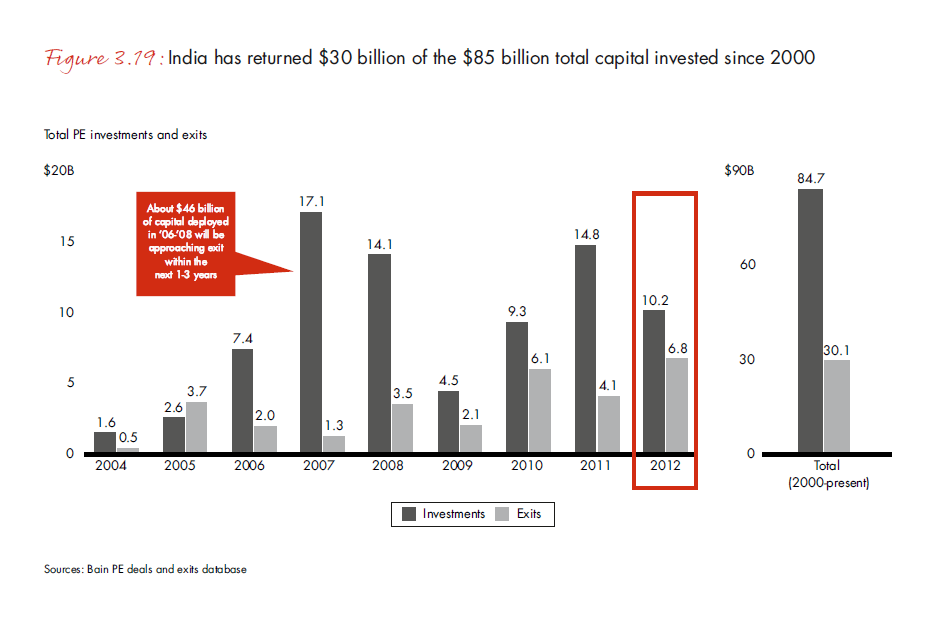
The vast majority of firms we spoke with believe that exits will increase in 2013, with a fifth expecting this increase to be over 25% (see Figure 3.20). Taking a slightly longer perspective, more than 40% of respondents expect exit volumes to rise significantly in the next three years, looking to healthy signs such as the increasing number of secondary transactions.
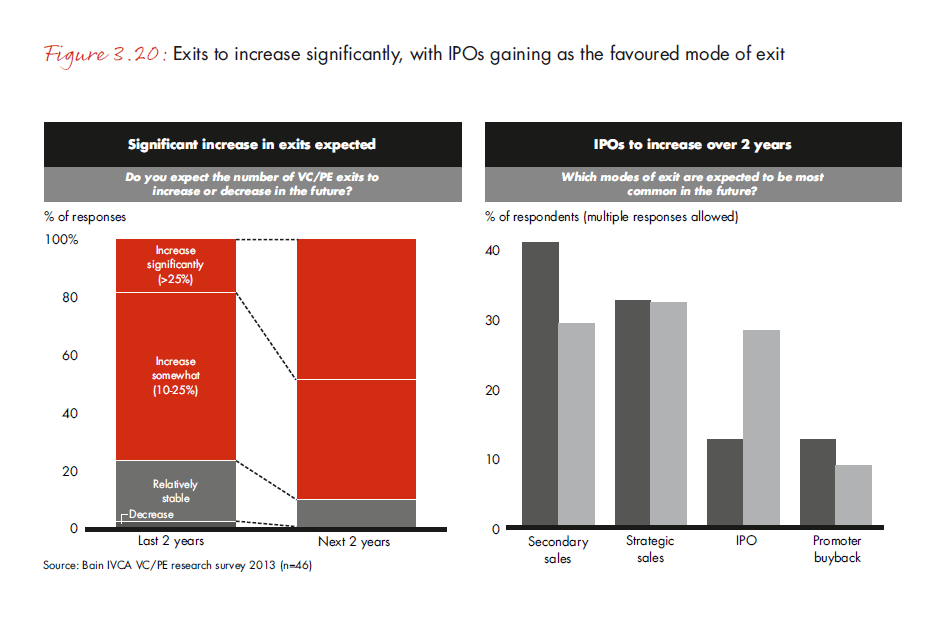
However, such opinions are based on expectations that capital markets will bounce back, which would increase investor appetite for PE-backed IPOs. In 2013, secondary and strategic sales will continue to be the predominant modes of exit. But looking further ahead, the industry expects IPOs to come to prominence in the next two years. The GPs we spoke to expect a threefold rise in the number of IPO exits between now and 2016.
Amid the uncertainty that we see at a global macroeconomic level, the only certainty ahead is that capital markets will continue to fluctuate. The pressure on GPs to exit will only grow in the coming year. The GPs we spoke with agreed that their priority is to get out of deals, rather than wait for the perfect valuation. However, this puts them in a difficult situation. On the one hand, an increasing portfolio of investments that they are unable to exit will significantly weaken their position with LPs, but on the other hand, accepting internal rates of return (IRR) below what might be considered an acceptable hurdle rate will make it very difficult to justify their investment philosophy for the next round of fund-raising. How firms will juggle these competing concerns in 2013 remains to be seen.
4. Investing in healthcare
Summary assessment
While private equity investments may have seen an overall decline in 2012, the healthcare sector has emerged as a sector of growth. The investments in healthcare almost tripled over the past year, rising from $0.46 billion in 2011 to approximately $1.3 billion in 2012. The number of deals also rose by 50%, with 44 deals made across the sector in 2012. All in all, India's dynamic healthcare sector promises to be an area of expansion in 2013, with high potential for both private equity and venture capital investment.
The healthcare sector is often broadly defined to include delivery centres/providers—such as hospitals and clinics, diagnostics, pharmaceuticals, medical devices, biotechnology, life-science companies and insurance firms—as well as some healthcare IT and business process outsourcing (BPO) companies. For the purposes of this report, we define healthcare as those industry segments relevant to private equity investment: delivery/providers, pharmaceuticals, diagnostics, biotechnology firms and clinical trial providers. We also include wellness-related outlets. While the healthcare industry includes insurance firms, these are not considered to be within the scope of traditional PE healthcare investments. Likewise, this report considers healthcare IT and BPO as a part of the IT industry.
Healthcare was the third-largest sector attracting PE investments last year, accounting for 12% of the total deal value, with as many as 46 firms making investments. Many funds, such as NEA, India Venture Partners and Aarin Capital, chose to make more than one investment over the course of the year. Sequoia Venture Capital, Goldman Sachs and the Halcyon Group were among the 13 funds that chose to follow their 2011 investments in healthcare with additional deals in 2012.
Closer analysis reveals that the delivery segment has driven the bulk of healthcare investments, accounting for 60% of the total funds invested. Not only has the volume of deals been high, but some deals have been of significant size, with $180 million invested in Manipal Health Enterprises by India Value Fund Advisor (over a period of four years) and $110 million invested by Advent International in CARE Hospitals.
Growth in India's healthcare sector has its roots in a number of factors, from ever-rising demand to government support. It is a vibrant space and one that holds many attractions for both promoters and investors. In this section of the report, we provide our perspectives on the healthcare sector, outline the opportunities it presents for private equity investors and identify key trends in investment in this industry.
Healthcare opportunities in India
The healthcare market in India is estimated to be $78 billion and has been growing at 11%, on average, from 2008 through 2012. That said, India is a highly underpenetrated market. The Worldbank's 2010 estimates revealed that India's per capita spending on healthcare was $50, trailing China's $221, and in a far different league than in the West, where the UK spends $3,500 and the US spends $8,400 per capita. India's ratio of nine hospital beds per 10,000 people is a fraction of those in the West (33 beds for the UK, 30 beds for the US) and lags behind those of fellow BRIC nations China and Brazil, with 42 and 24 beds, respectively (see Figure 4.1).
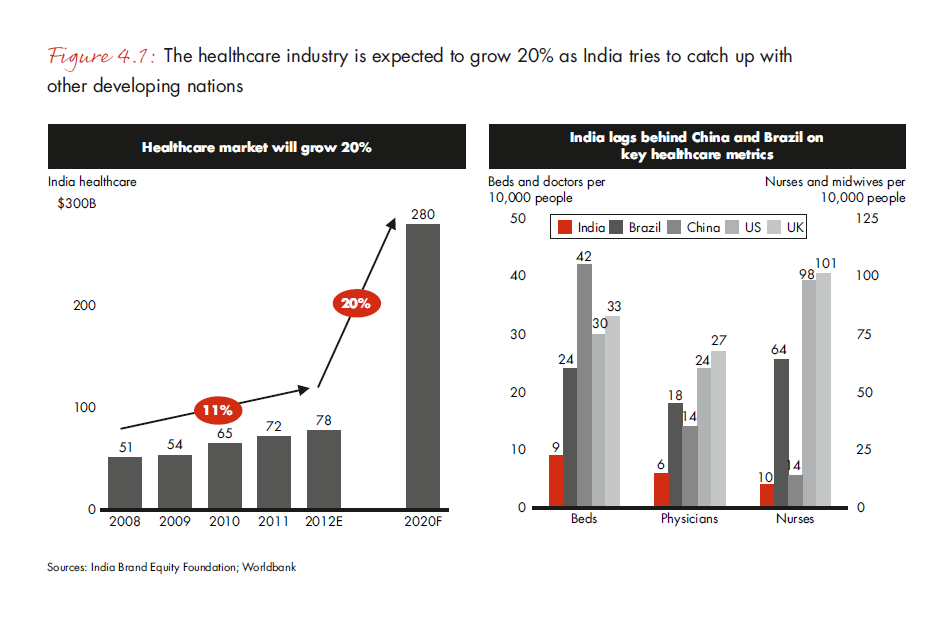
In terms of professional staff, India also has a long way to go. India has six physicians per 10,000 people, whereas China has 14 physicians and the UK has 27. India has 10 nurses and midwives per 10,000 people, compared with China's 14, Brazil's 64 and the US's 98 nurses and midwives. This massive need is inevitably driving growth, as India's GDP continues to improve.
India Brand Equity Foundation suggests that the already high CAGR for the healthcare sector is expected to accelerate by 20%, meaning that the market will be worth $280 billion by 2020.
Many factors are propelling this rapid expansion (see Figure 4.2). A few key influences are:
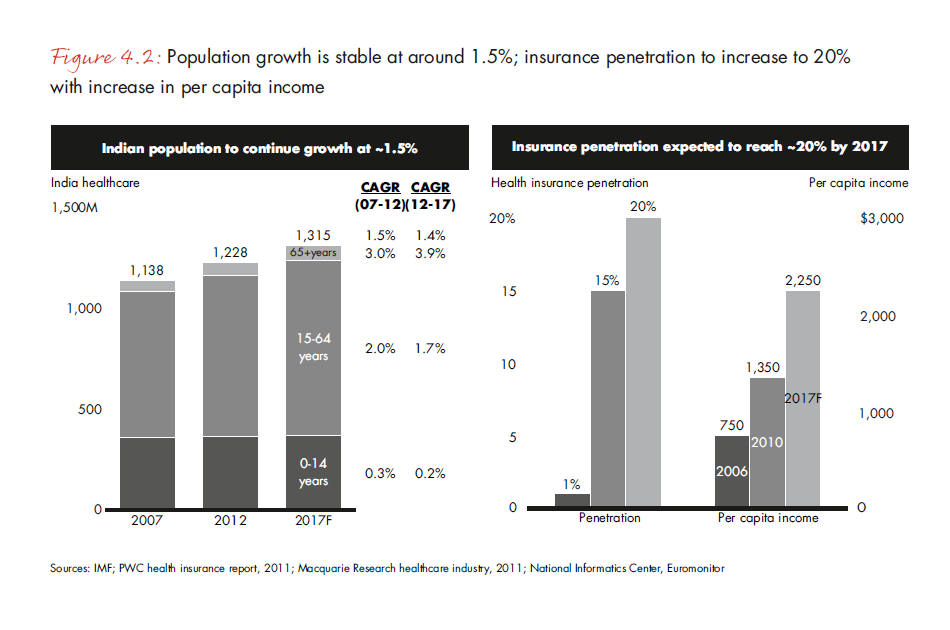
- Growth in population. India's population has increased by 1.5% per year for over a decade now, and this trend is expected to continue. The population over the age of 15 is expected to grow even faster, at around 2% per annum.
- Increasing incidence of diseases. Lifestyle diseases, such as diabetes and heart disease, have grown at approximately 3% and 9%, respectively, in the last three to five years. The prevalence of these conditions shows no signs of decline and is going to push the demand for healthcare higher.
- Increased affordability. India's per capita disposable income is expected to increase by about 1.6 times by 2017 to around $2,300 per person. The percentage of families counted as “high income” is expected to double by 2025, up from 20% in 2010. Healthcare will inevitably see an increase in spending as families at the bottom of the pyramid move above the poverty line.
- Rise in insurance. Health insurance penetration is expected to increase to 20% by 2017, up from 15% in 2010. This is still low but will have a real impact on both attitudes and spending when it comes to healthcare.
- Government schemes. Schemes backed by central and state governments, such as Aarogyasri in Andhra Pradesh, are making healthcare services affordable to the large sector of Indian society below the poverty line. Aarogyasri was launched by the state government in 2007 and provides insurance coverage worth INR 2 million (~$ 4,000) per family. It provides tertiary care, including 942 selected medical procedures, and free follow-up for families living below the poverty line. What this also means is that hospitals are able to invest in infrastructure, needing only to recoup marginal costs with the certainty that the beds they provide in specialty hospitals will be filled.
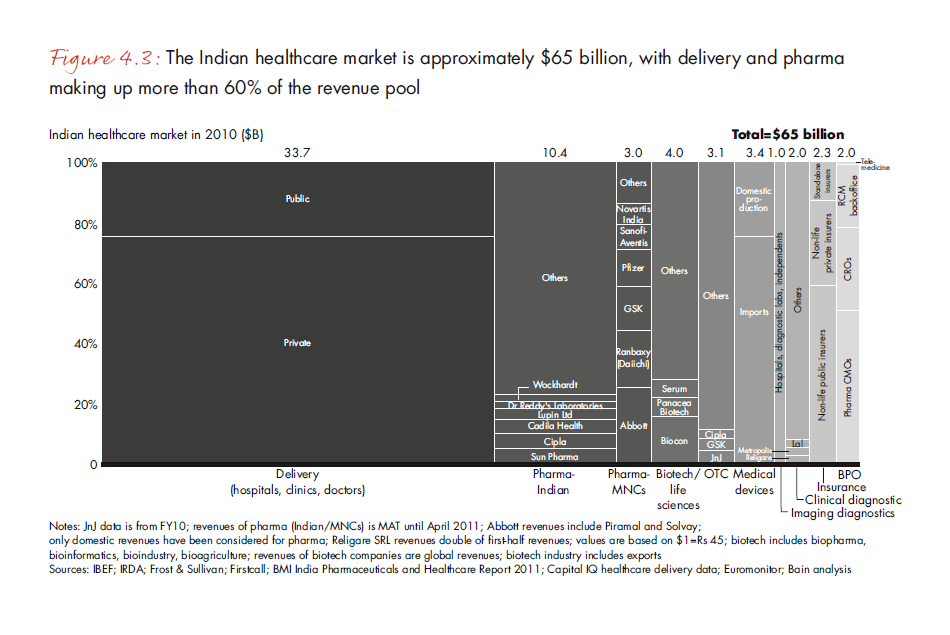
Two segments are critical to the healthcare space in India: pharmaceuticals and delivery. In 2010, delivery services and pharmaceuticals comprised more than 60% of the $65 billion market (see Figure 4.3).
The delivery segment is the most promising segment, currently witnessing high operating margins. These can reach 18% to 20% in national chains, where margins are expected to grow in the next year and reach up to 8% to 10% in other subscale entities (see Figure 4.4).
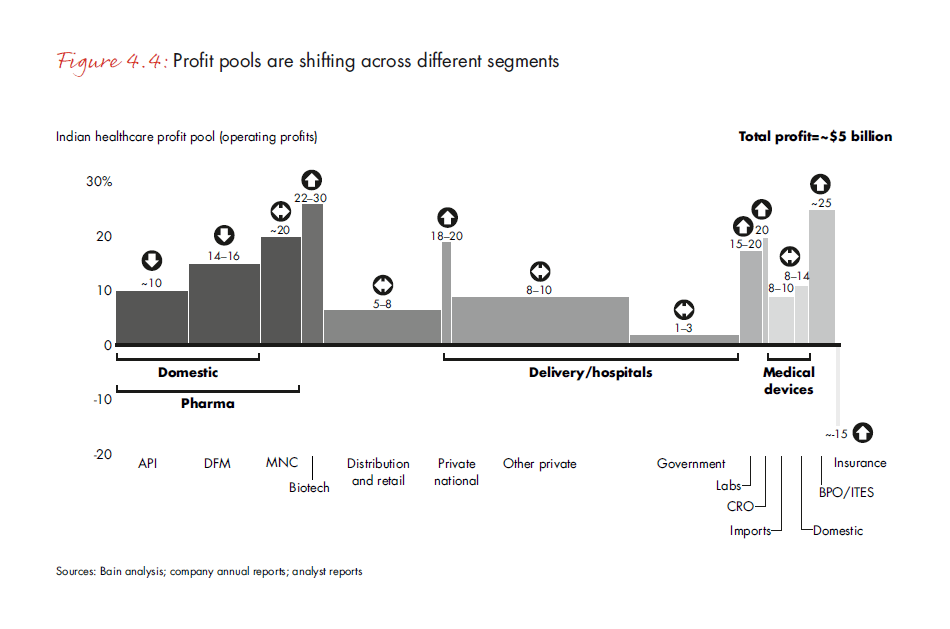
Of the nearly $1.3 billion invested in healthcare in 2012, a majority ($0.7 billion) have been late-stage ventures. However, there has been an increase in early-stage deals, which could present interesting opportunities when those businesses seek their next round of funding.
Most deals in the healthcare sector are currently minority stakes, and this is expected to continue in the year ahead. Around half of the deals fell under the $10 million mark, both last year and in 2011 (see Figure 4.5). But 2012 has seen a clear rise in scale deals. There were four deals valued at $100 million or more, all in the delivery subsector:
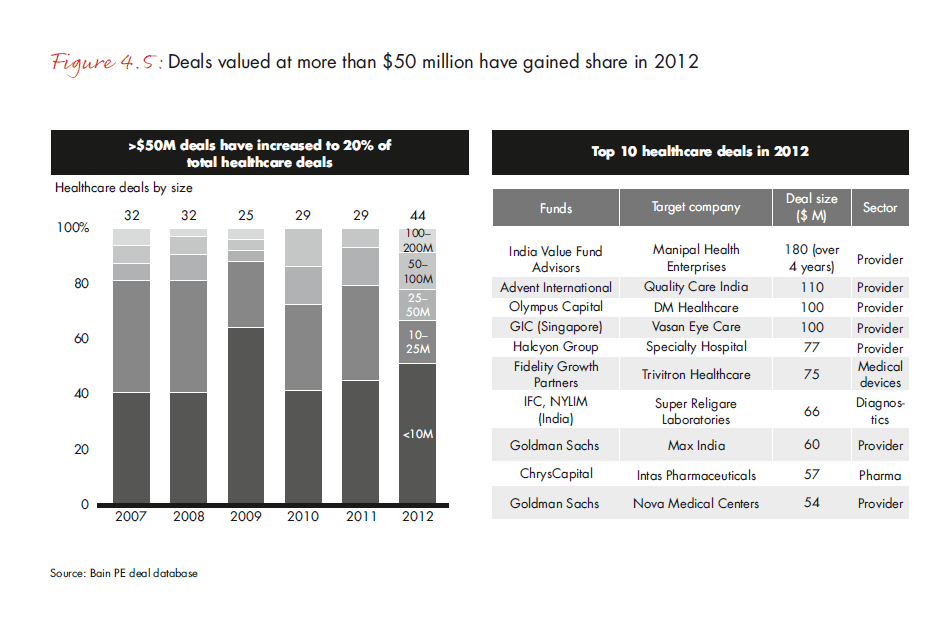
Manipal Health Enterprises, Quality Care India, DM Healthcare and Vasan Eye Care. The average deal size in this sector has increased from $16 million to $28 million over the past year. In delivery, in particular, the average deal size has more than doubled, from $17 million in 2011 to $40 million in 2012. This is mainly due to the increase in deals valued at more than $50 million, which have tripled from two in 2011 to six in 2012.
Turning to investors, our research shows that, of the 285 funds active in India in 2012, 46 invested in healthcare. A longer view shows that 66 funds invested in healthcare over the past two years, and from this group, 13 funds invested in both 2011 and 2012.
Given the rapid expansion in the healthcare sector, it is not surprising to note that venture capital funds have participated actively in the space. Over the past two years, GVFL invested in Axio Biosolutions, and Rajasthan Venture Capital made deals with Frontier Lifeline (investing approximately $3 million) and Imaging Super Consultant (investing about $1.5 million). Meanwhile, Sequoia invested heavily, with $20 million in Moolchand Healthcare, approximately $7 million in Suburban Diagnostics and about $3 million in Glocal Healthcare Systems.
The interest of local GPs and global investors in Indian healthcare is not surprising given the recent success stories of value creation in healthcare. Paras Pharma is one such example: Actis and Sequoia invested $56 million in 2006 and exited in 2010 via a strategic sale for $466 million that yielded an eightfold return.
Healthcare continues to present a unique opportunity for private equity and venture capital investors for the following reasons:
- Sound fundamentals for growth. The healthcare sector presents limited risk, as most growth drivers are macroeconomic and informed by highly reliable data and trends. It's estimated that India is 20 to 25 years behind the US in terms of the maturity of the healthcare sector, and there is growing confidence that India will follow the same trajectory as the US.
- Established track record of value creation. Over the last five to seven years, several healthcare businesses have shown attractive growth and margin expansion records.
- Recession-proof nature. Given the current uncertain economic climate, it is not surprising that PE and VC investors have focused their attention on healthcare, along with consumer goods or services.
- Government support. Across India, state governments are making a commitment to improve the health of citizens. Government support has also addressed a key issue: the cash transactions, which made PE firms uncomfortable. An improved policy framework and increased insurance penetration mean the industry is seeing more white money, with neater transactions and a more suitable environment for larger investments.
- New delivery models. Resource constraints have pushed innovations such as short stay centres and specialised delivery centres through specialist hospitals like Vasan Eye Care or Nephroplus, a renal care unit. As companies offering these new ways of delivering healthcare services seek to stabilise and scale up, their demand for capital is growing.
- Value addition of VC and PE investors. Most healthcare companies are run by medical professionals or a family of doctors, who are commercially oriented but often lack strategic vision or a professional management approach. Such firms may have limited business experience and are often looking for skills and competencies that can supplement their technical knowledge: a win-win situation for private equity investors.
- Track record of exits. While the number of exits seen in the healthcare sector is in line with the overall exit rate (47 out of 288 investments have exited so far), the value of those exits is more positive. Of the $5 billion invested into healthcare, $2.8 billion has been returned, an improvement on India's overall track record of $30 billion of returned capital from the $85 billion invested.
Our interviews with a few healthcare entrepreneurs suggest that they are very cognizant of the value of their partnerships with PE and VC funds. Some of the key areas where they derived the most benefit include help with strategic planning, developing the company vision, guidance on how to scale up and realise the full potential of their current platforms, improvement in all-around performance through significant inputs in marketing and advertising, and, finally, support for the acquisition and training of management talent.
All these factors point to the important role that both venture capital and private equity have to play in the Indian healthcare sector. As the healthcare sector continues its rapid growth, we are likely to see an accompanying rise in the levels of PE involvement.
Investing in healthcare: Trends and future outlook
Over time, investments in the healthcare sector in India have shown steady growth. The number of deals has increased by 50% in the last year. The total funds invested have tripled over the last three years, from $345 million in 2009 to almost $1.3 billion in 2012.
Within healthcare, there has been a move away from investment in pharmaceutical companies towards the delivery/provider subsector.
Healthcare investing in India took off with pharmaceuticals, as the generics opportunity opened up possibilities from 2003 to 2004 and onwards (see Figure 4.6). However, by 2008 this trend had matured, peaking in 2005 when healthcare investments made up 11% of the total funds invested. The years 2009 to 2010 saw some investment in diagnostics, which has since subsided. Investments in the delivery space began about five years ago, but it is only recently that this interest has picked up.
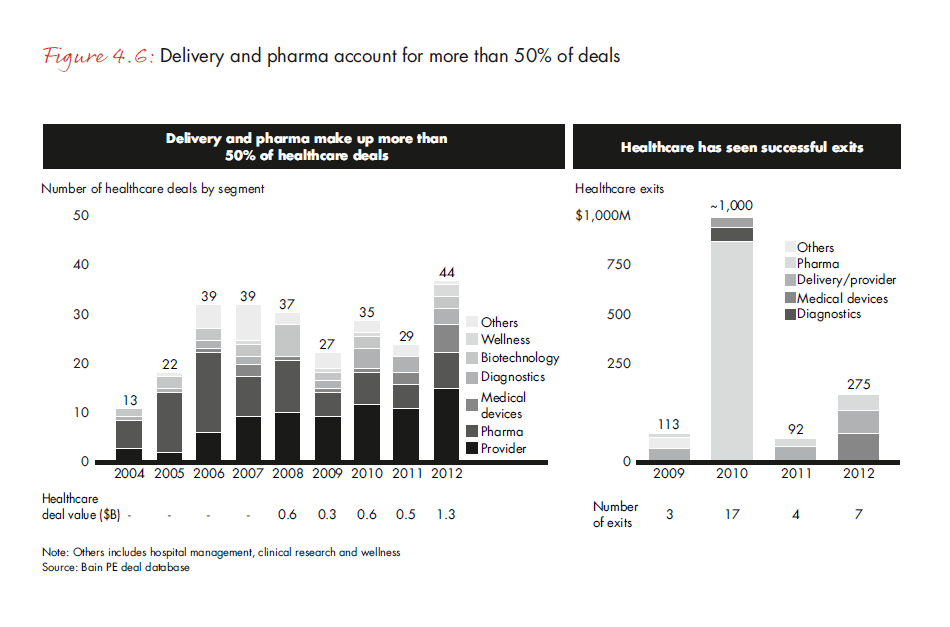
About 140 healthcare companies have received investment over the past five years. Of these, 15% to 20% have raised more than one round of capital, pointing to increasing confidence in the value-creation potential of the sector. The picture is also promising for exits. Of the $5 billion invested in healthcare, $2.8 billion has been returned, with an average holding period of five years for the top 25 deals. The biggest exits in 2012 were Trivitron, sold by ePlanet Ventures and Headland Capital; and Arch Pharmalabs and Sahyadri Hospitals, both sold by ICICI Venture (the former sold with IL&FS Investment Managers). Of the 115 total exits in 2012, which we explored in section 3, seven were in healthcare. A large proportion of these exits (three out of seven) were in delivery. Public market sales, including IPOs, seem to be the most popular exit routes, constituting 40% of healthcare exits in the last three years. Delivery seems to be the easiest segment to exit, while wellness and medical devices are still relatively new in vintage.
Healthcare is an industry clearly set to grow in India, and one in which private equity and venture capital can play an active role. Entrepreneurs already value PE and VC funds for the skills, expertise and network they bring to the table that other sources of capital are unable to provide. We predict that the next few years will continue to see momentum for deal activity rise in this exciting space.
5. Implications
On the whole, 2012 was a challenging year. Nonetheless, the year saw many positive signs, from a welcome increase in exits to improved regulatory clarity. Perhaps most important, it was a year in which both entrepreneurs and investors became more comfortable with their respective roles, a sign that India's private equity market is moving towards maturity.
Among entrepreneurs, we've seen an increase in their willingness to engage with private equity investors and accept the support that traditionally accompanies this type of funding. As PE becomes an accepted source of capital, entrepreneurs are waking up to the potential of hands-on support from investors.
Among investors, we've seen a change in attitude. As their understanding of the market has deepened, they have become more cautious about where to invest. Funds are also seeking to differentiate themselves in a market that's still not large enough for real specialisation, but where competition over high-quality deals is growing.
This report offers lessons for each of the key stakeholders:
General partners. First, GPs should work on building strong relationships with entrepreneurs much earlier in the deal cycle. In fact, networking and relationship management are more critical in India than in other markets given the current paucity of quality deals. Second, GPs should explore opportunities to invest with existing promoters or to re-up existing investments. This would provide a natural advantage from the start and avoid unnecessary competition. Third, as we've seen, it's essential to place more emphasis on holistic diligence. Fourth, GPs should take care to discuss their investment theses and value-creation blueprint with the entrepreneur throughout the deal-making process. A carefully prepared diligence document can act as a differentiator with the entrepreneur, demonstrating understanding of the business and facilitating agreement on key objectives.
Indian entrepreneurs. One important point for India's businesses is to be open and transparent from the start. PE should not just be seen as a way to access cash, but rather thought of as activist capital, which brings vast expertise, network and fiscal discipline. Entrepreneurs should also take care to agree on the operating model with the private equity fund—to decide the latter's level of involvement right from the start, and align with the senior management accordingly. It is equally important to understand that investors come in with a set exit time frame in mind, and it is best to align on the exit road map early in the relationship.
Limited partners. The key issue for funds in India is patience when faced with a growing portfolio. They may need to reevaluate their exit options in some cases and make tough calls on the IRRs that they're looking for. With the increasing number of unexited investments over five years old, LPs need to be extremely picky about the GPs with whom they work, scrutinising their exit and investment track records. An important lesson here again is to create a clear exit road map on all new investments. This should be an integral part of the diligence process.
Public policymakers. Looking to 2013 and beyond, there is much that can be done to stimulate private equity investment in India and promote economic growth. India currently requires extensive capital across multiple sectors: infrastructure, telecom and education, to name just a few. Policymakers should realise the benefit of PE funding—involved and available capital with shared risk. They should also recognise the value that private equity can bring to Indian entrepreneurs in terms of expertise and guidance.
Private equity funding will only grow in India if the policy framework is supportive. Policymakers need to be quick and decisive in creating new legislation. When the government hesitates, as with the GAAR case, confidence over India as a potential investment destination is inevitably affected.
Apart from this, policy makers also need to consider opening up other avenues for domestic firms to obtain domestic funding. Allowing insurance firms to provide capital, for example, would bring India further in line with global standards and make it easier for new business to flourish.
The year 2012 may not have been a boom year for Indian private equity, but it was a year that showed signs of hope for the future. There's no doubt that private equity investment will increase in the coming years as India's need for flexible capital continues. Stakeholders across the industry need to work together with trust, transparency and motivation to create a healthy investment landscape.
Arpan Sheth leads Bain & Company's Private Equity practice in India and is the main author of this report. He is a partner based in the firm's Mumbai office. Sriwatsan Krishnan is a manager with Bain & Company and is a member of the India Private Equity practice. He has co-authored this report and is based in New Delhi.





























